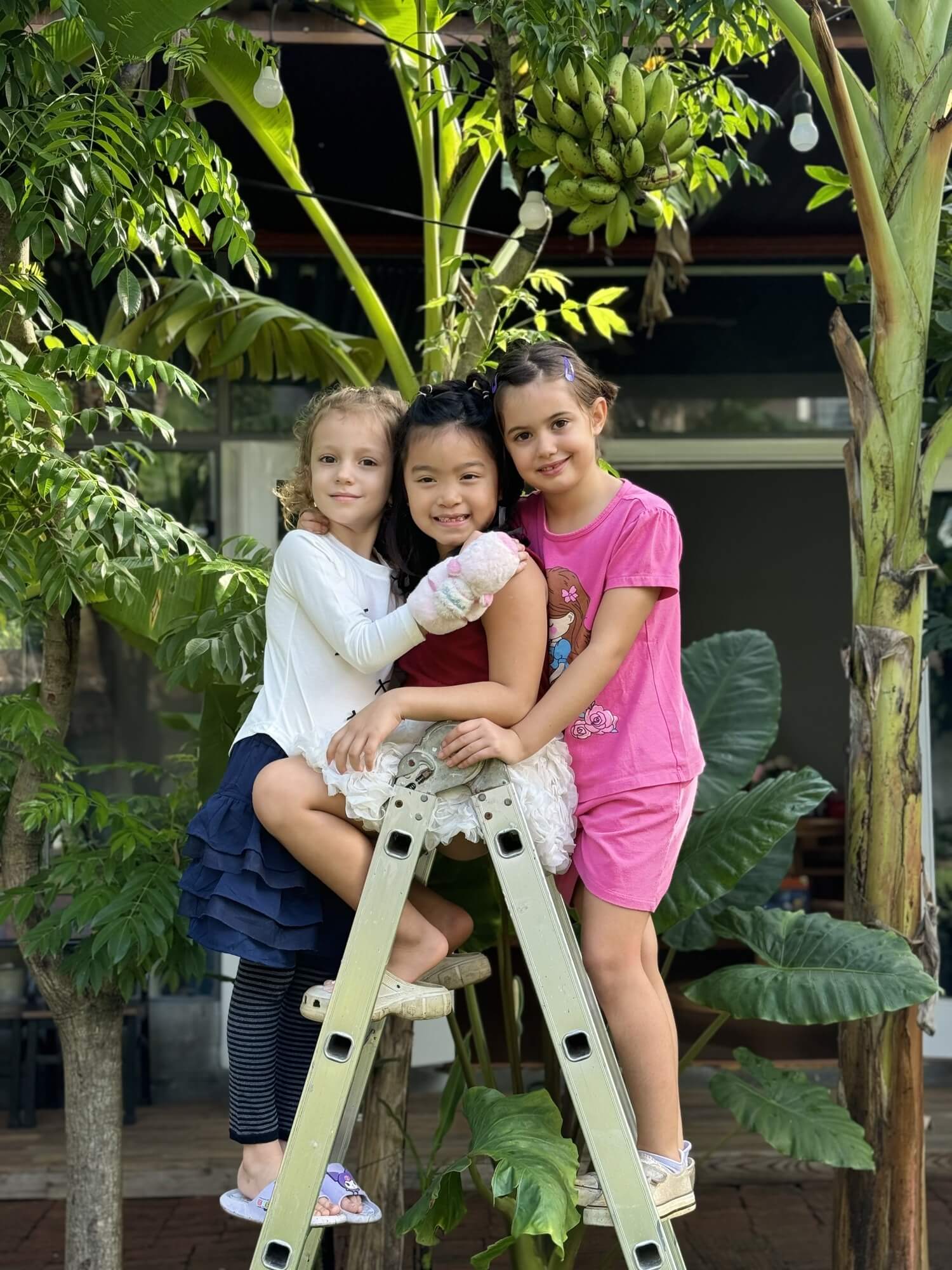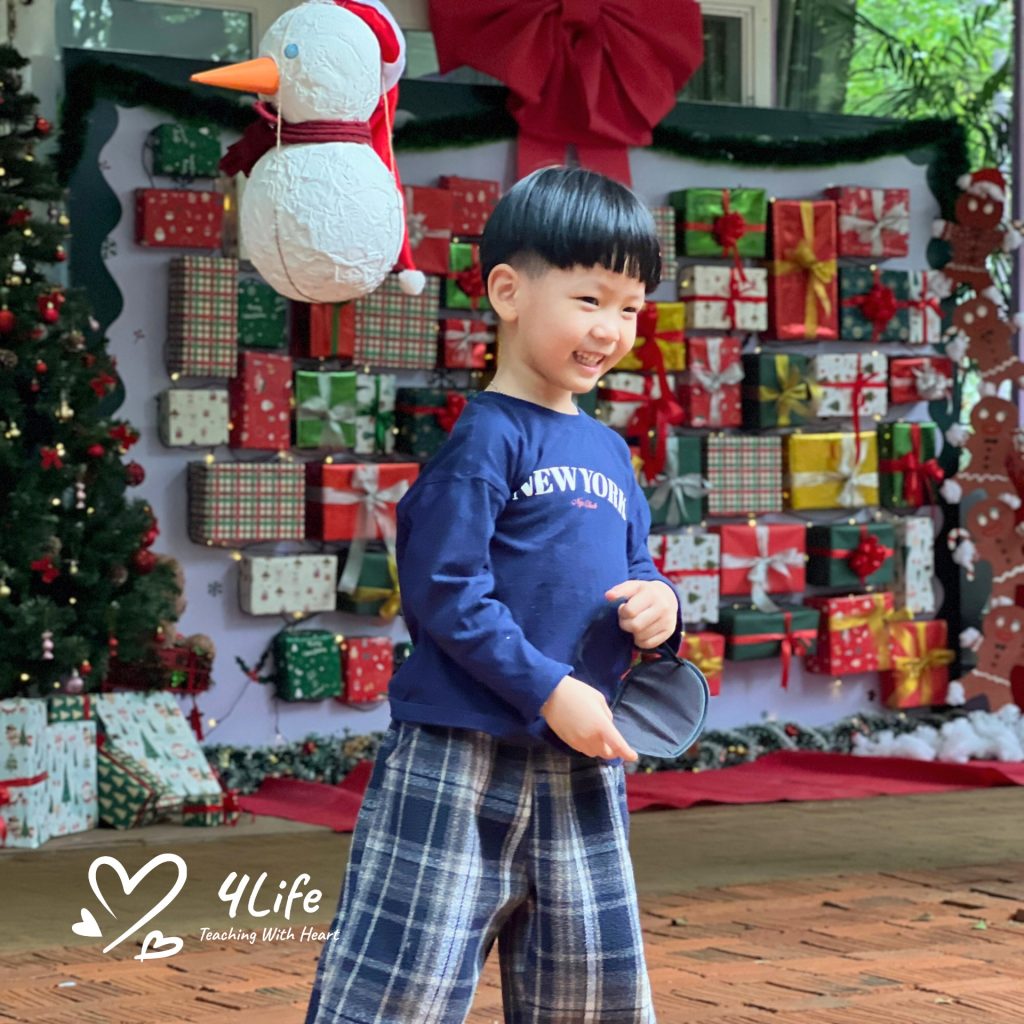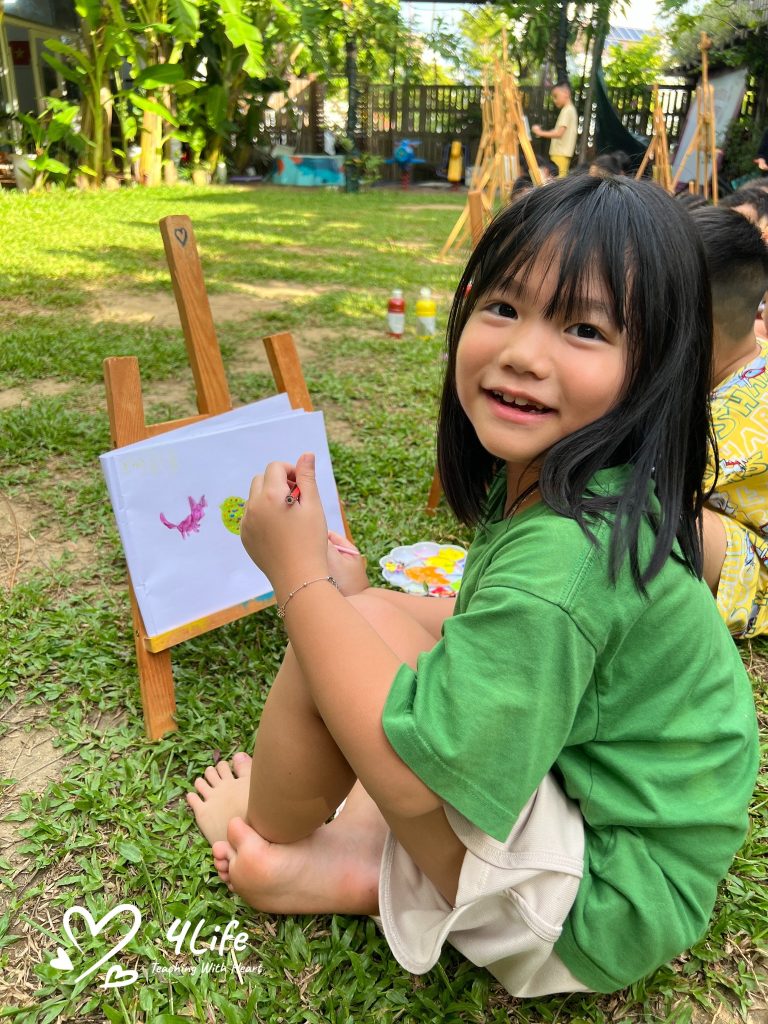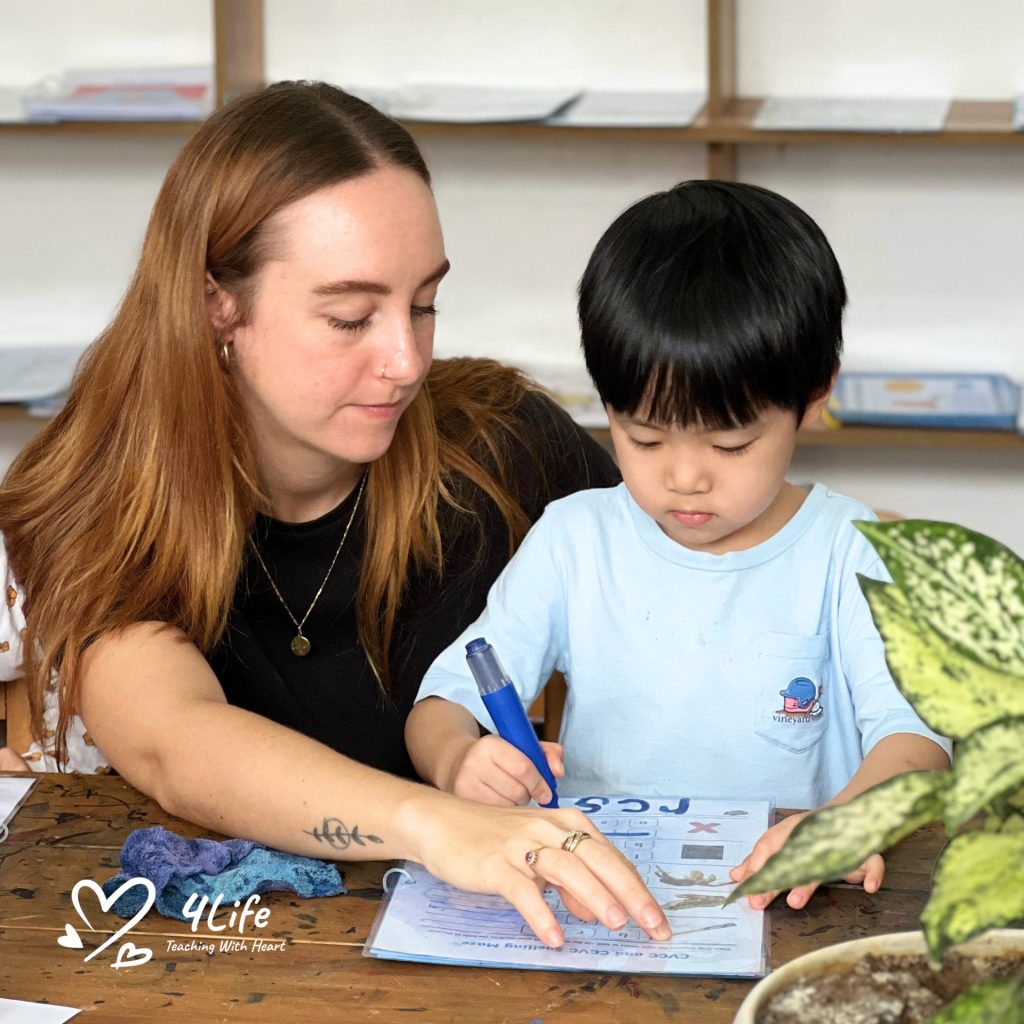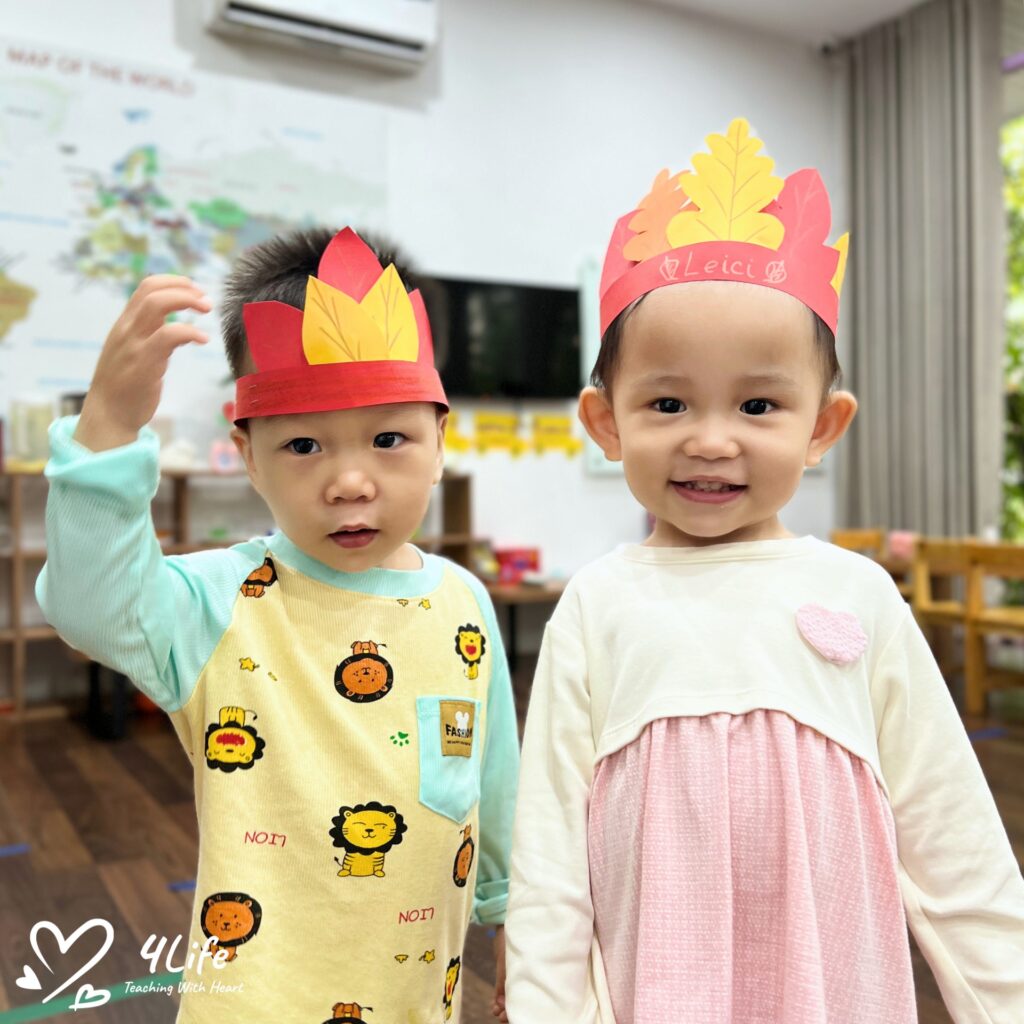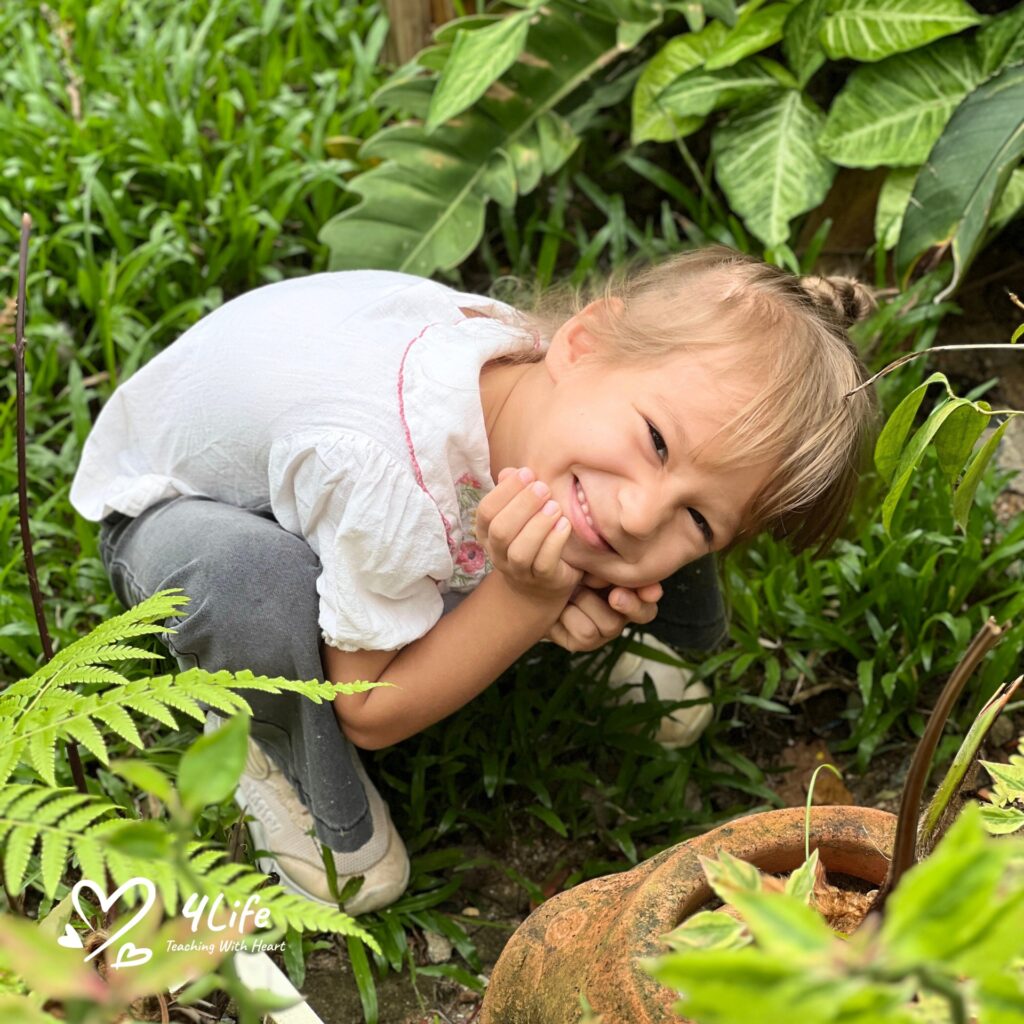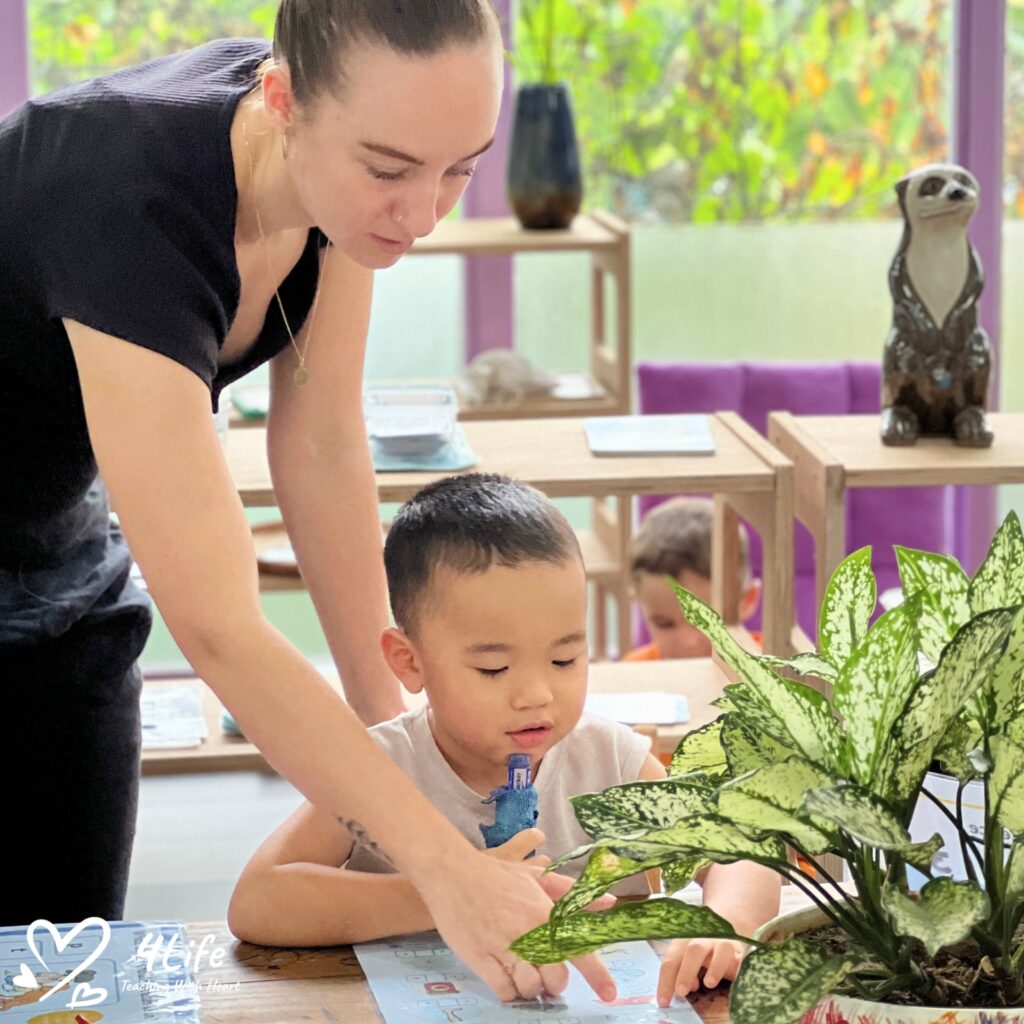4Life Kindergarten Curricullum
Class structure
4Life Montessori Kindergarten Program is based on the “Happy Life” – 4Life philosophy and utilizes the Montessori method, incorporating Inquiry Learning Through Integration and Playing.
The curriculum areas currently included are: Practical Life Skills, Sensorial, Language Arts, Mathematics and Geometry, Geography, History, Science, Economic Education, Invention – Industry – Technology, Movement and Physical Education, Cosmic Studies, Visual Art, Music.
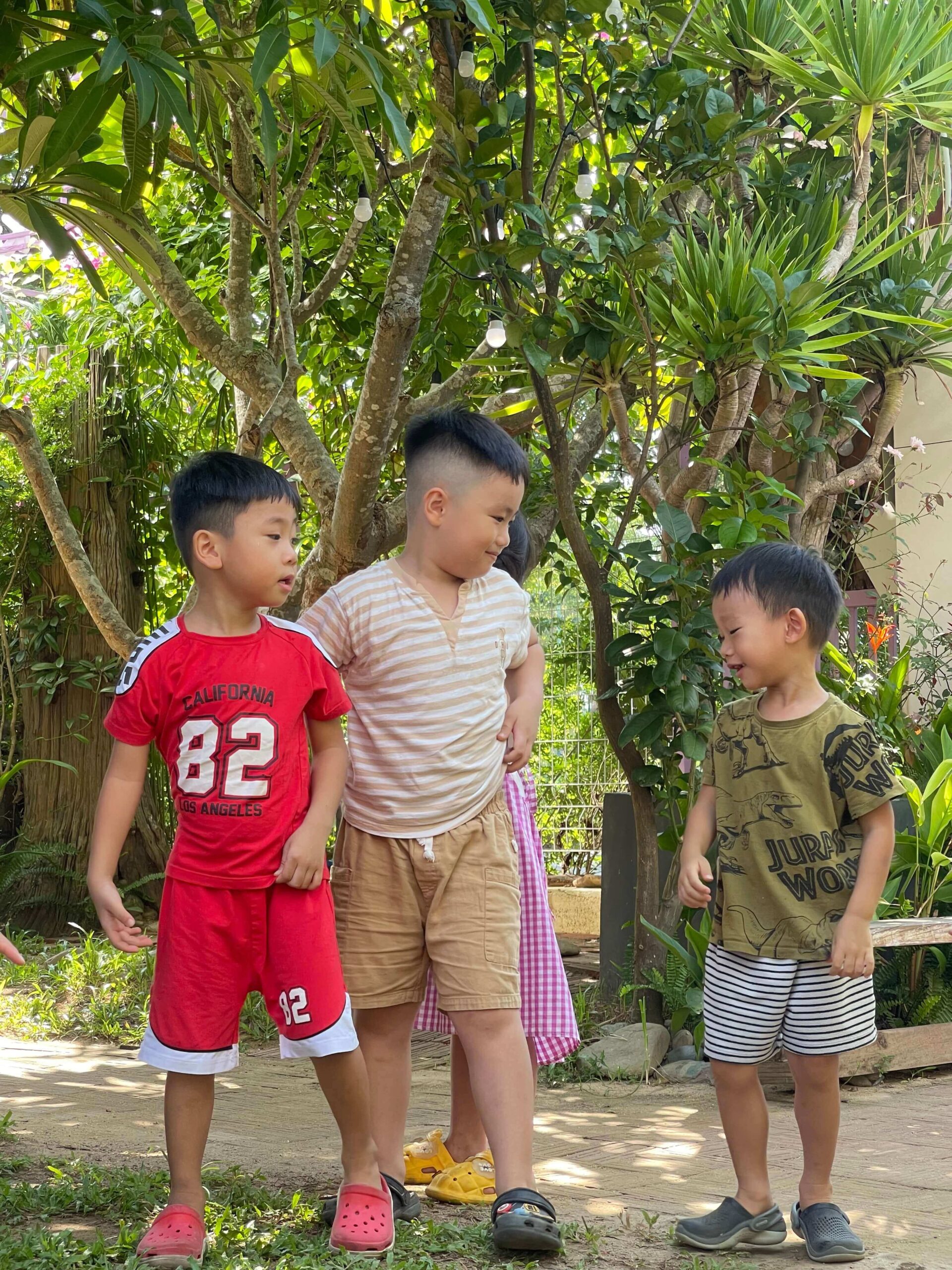
Nursery
Children ages: 6 months to 2 years;
Each classroom: 10 infants (max allowed);
Teachers: One Vietnamese teacher for each infant, collaborating with International teachers in group work;
Program: 4Life Montessori for Nursery.
Read more »
Junior
Children ages: 2 to 3 years;
Each classroom: 15 toddlers (max allowed);
Teachers: 1 International teacher and 2 Vietnamese teachers;
Program: 4Life Montessori for Junior.
Read more »
Senior
Children ages: 3 to 6 years;
Each classroom: 15 kids (max allowed);
Teachers: 1 International teacher and 2 Vietnamese teachers;
Program: 4Life Montessori for Senior.
Read more »
Nursery Curriculum
The Nursery, or nest, is a nurturing home-like environment for infants from 6 months until they are walking independently and focusing for an hour (around 18/24 months).
Nursery environments in 4Life Montessori are prepared to be as homelike as possible, and to involve small children in a round of daily activities including quiet times and rest periods. The characteristics of these environments include:
• Continuity of care;
• An ordered physical environment;
• Consistency of activity and expectation.
In environments with these characteristics, infants build a sense of security, a sense of order, and a sense of time.
During this stage of development, infants experience sensitive periods for various skills, including movement, hand-eye coordination, language acquisition, understanding order, manipulating small objects, and toilet training. The design of the infant classroom and the educational materials inside are tailored to reflect these interests and provide ample opportunities for learning.
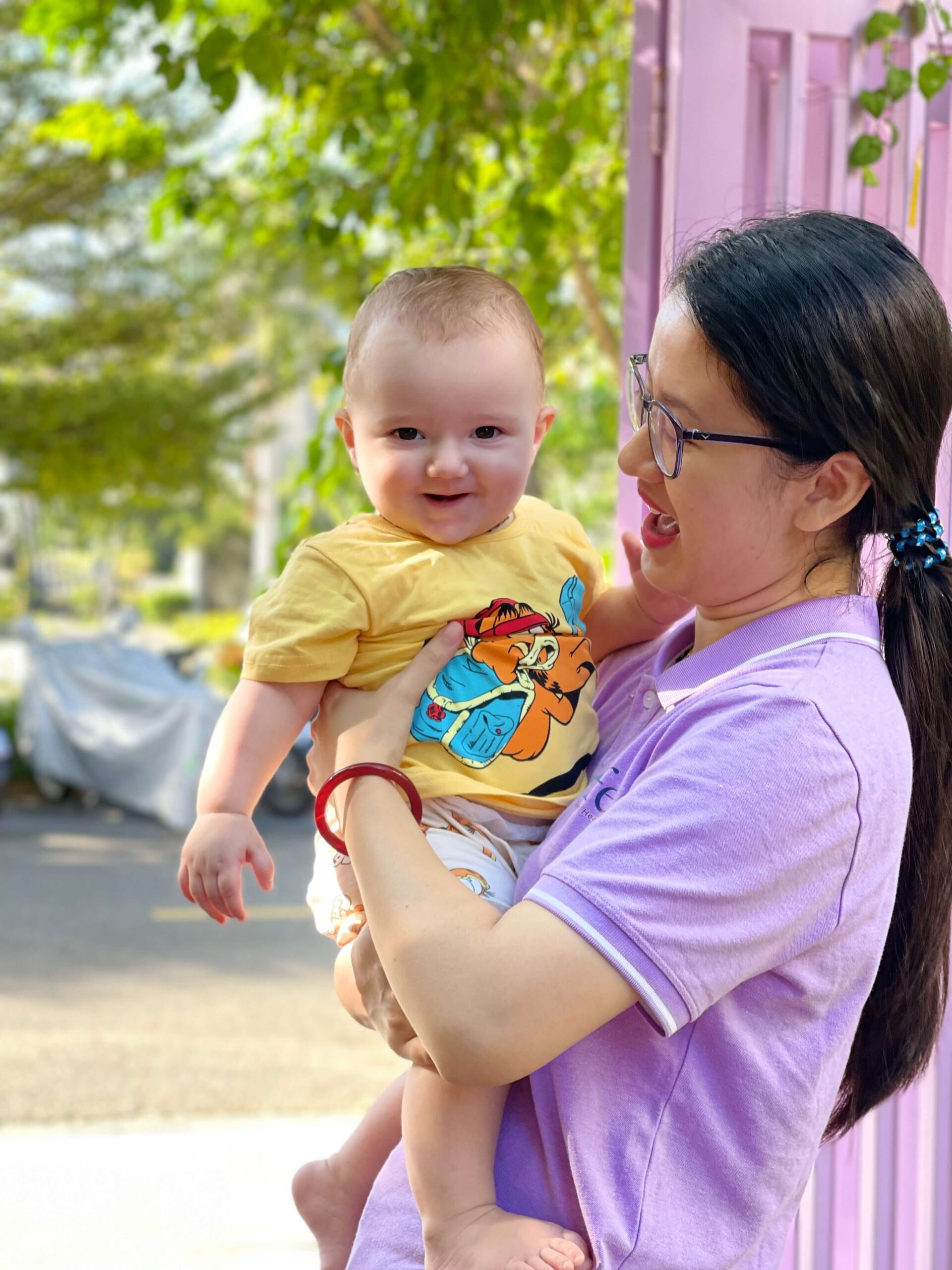
Additionally, the daily routine is structured to meet the needs of this age group, emphasizing consistency and repetition while also accommodating each child’s individual needs, interests, developmental stage, and learning styles.
Before finishing the Nursery program, infants have approximately 6 months to adjust to an environment that demands higher concentration and longer periods in a Junior class (for toddlers aged 2-3 years). During this “internship,” infants engage in activities in the Junior class for gradually increasing durations, with the continued support of an individual teacher, similar to their experience in the Nursery class.
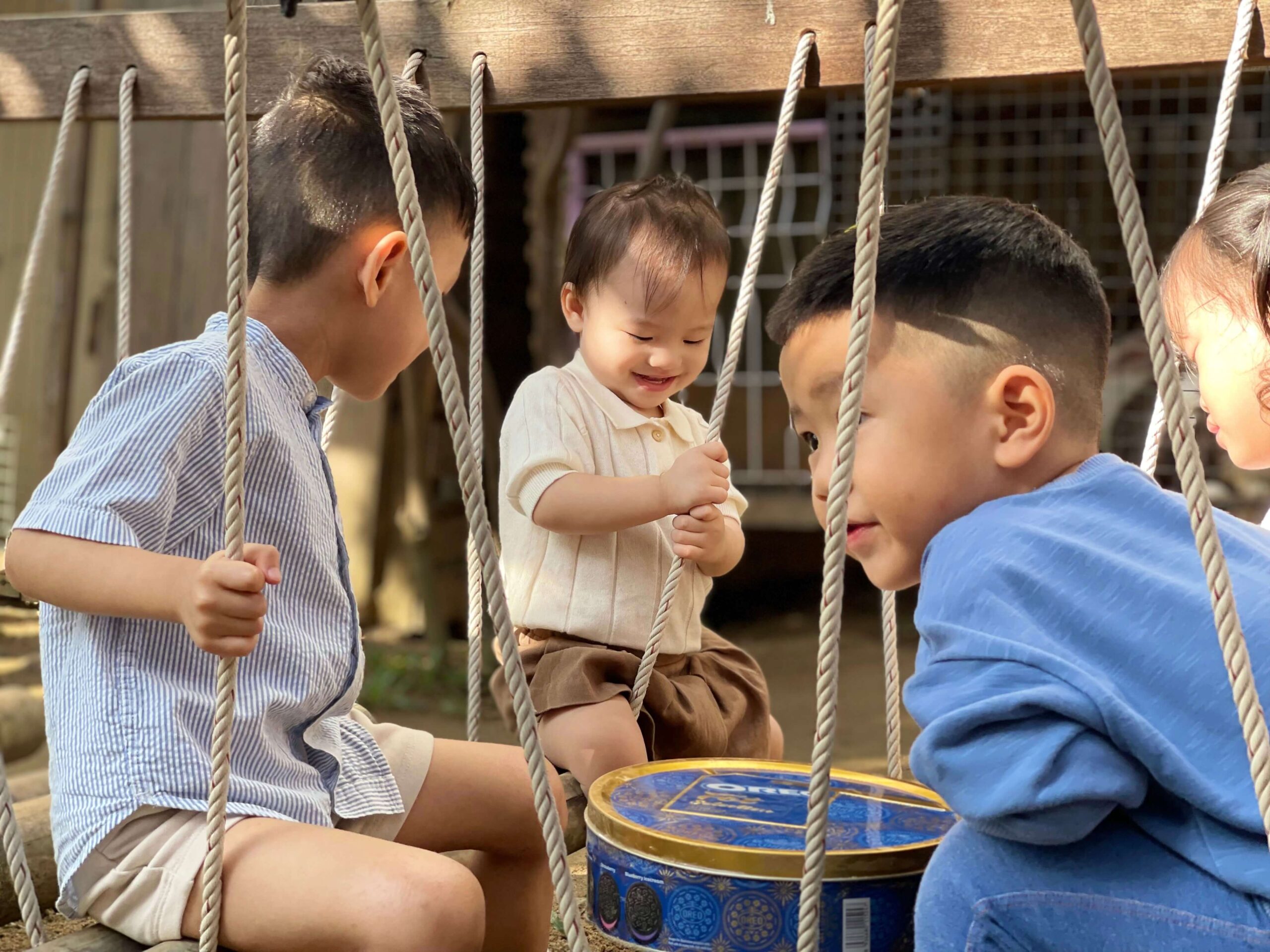
Nursery learning basic goals
– Achieving physical development milestones such as crawling, walking, climbing, running, and jumping;
– Demonstrates independence skills, such as self-feeding;
– Begins to use one- or two-word phrases. Begins using spoken language to name familiar people and objects, as well as to express basic needs such as hunger, thirst, heat, cold, pain, and itching…
– Recognizes the names of body parts, colors, and shapes;
– Plays alongside other children;
– Selects an activity and puts it away;
– Explores objects in various ways;
– Uses simple gestures to communicate. Form the habit of going to the toilet on time, knowing how to notify the teacher when you need to go to the toilet. Limit the use of diapers (usually only used during nap time);
– Develop good habits such as washing hands before and after meals, and cooperating with teachers during changing clothes and bathing.
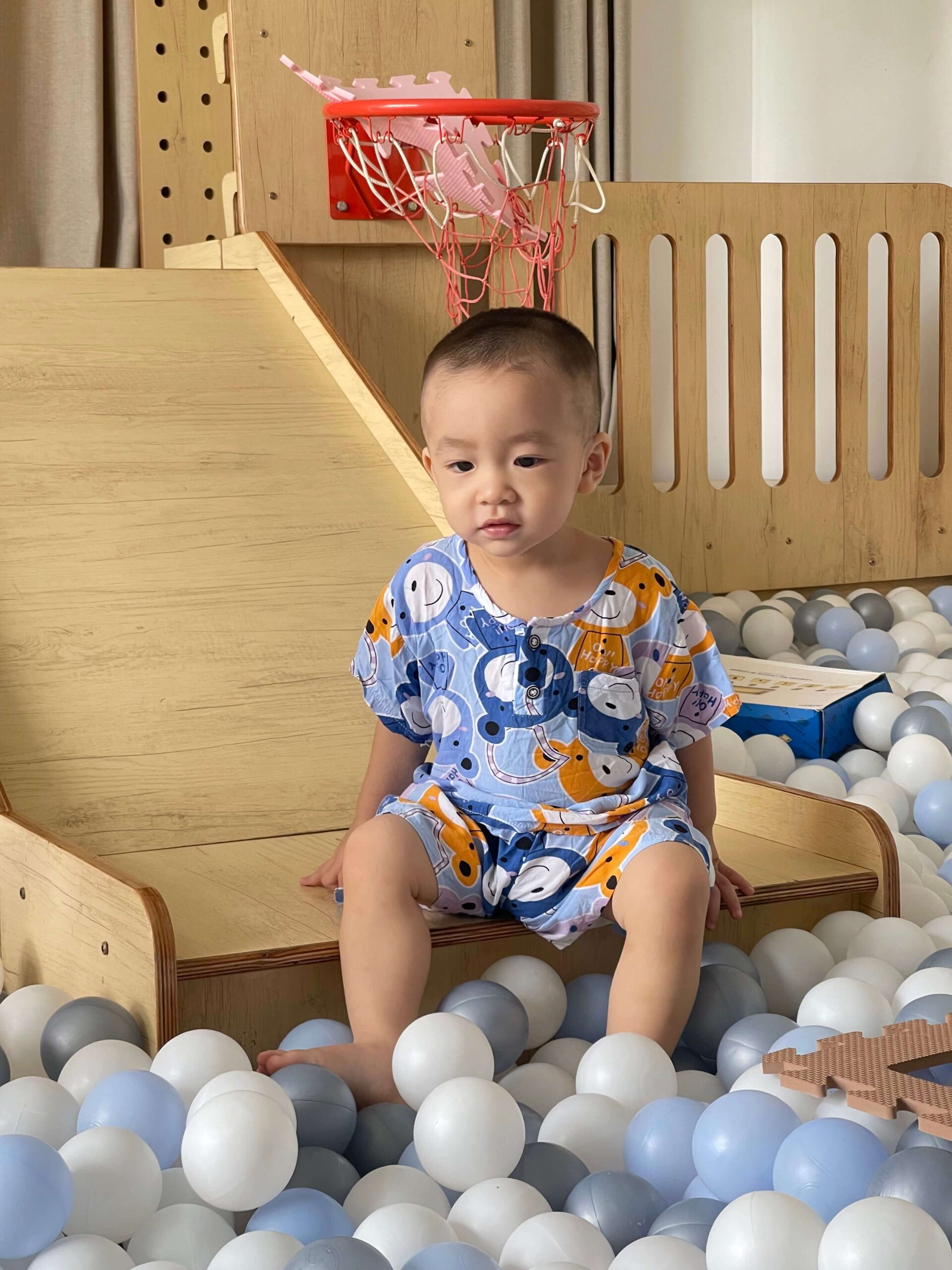
1. Cognitive Development
Infants joyfully connect object names with images, skillfully use items as intended, eagerly search for partially hidden treasures, thoughtfully reach for challenging objects, and delight in discovering hidden surprises all around them.
2. Integrated Eye-Hand and Cognitive
Infants are supported in their essential growth through interactive play. They explore hand-to-hand transfer by moving objects between their hands and practicing placing items into containers. Using Object Permanence Boxes, infants refine their hand and finger control while grasping the concept that objects continue to exist even when they are out of sight. They also engage with various Imbucare Boxes to develop their coordination and understanding of shapes.
Additional activities include hanging knitted balls to improve fine motor skills and color matching, placing pegs into holes to sort colors, completing simple puzzles to enhance eye-hand coordination, and manipulating disks and cubes on dowels to improve grip and coordination.
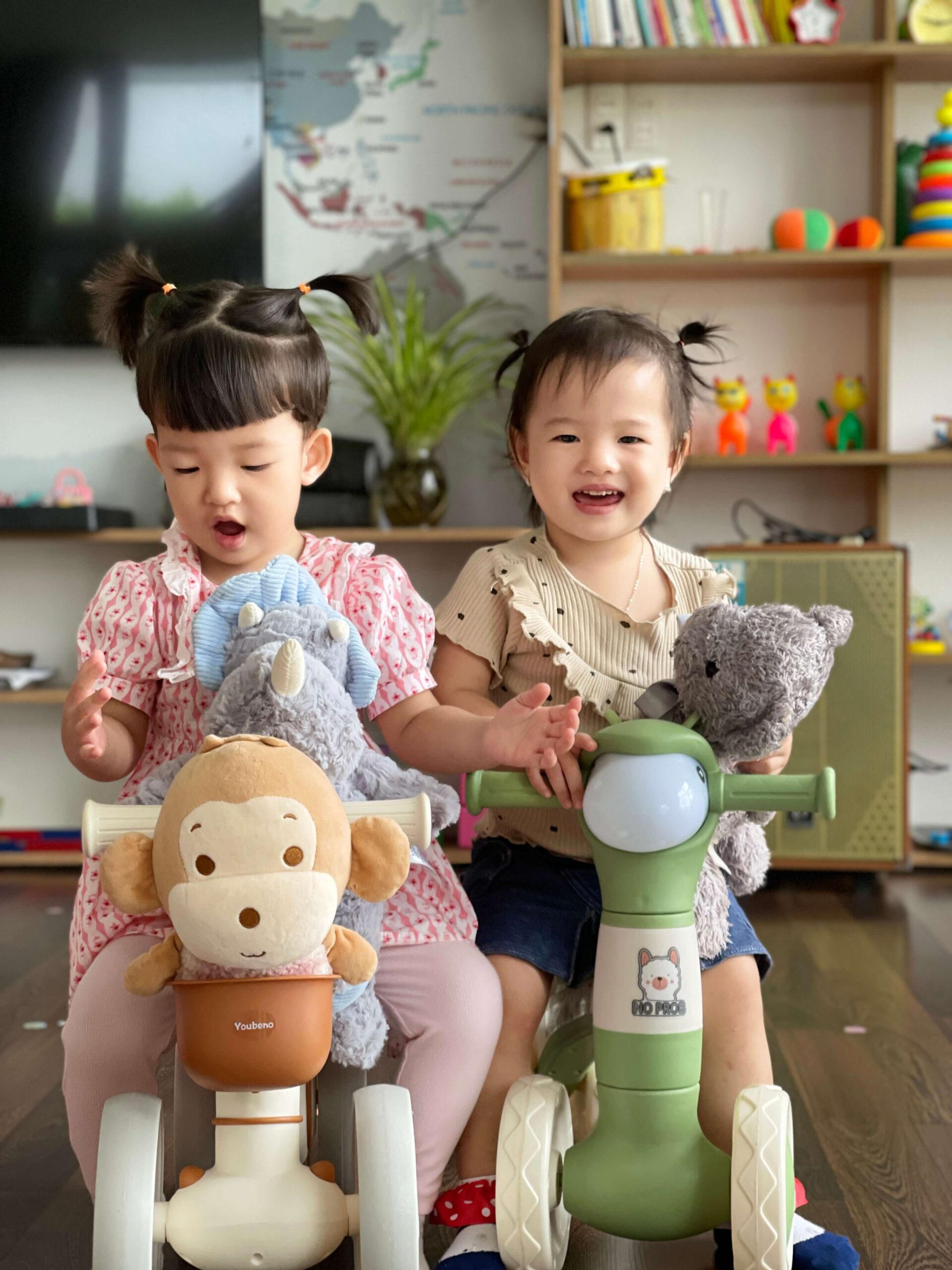
3. Language
Teachers engage infant with a variety of sounds and tones. Respond to their coos and cries to encourage them to communicate their needs. Play simple word and movement games, as these can bring them joy and stimulate their interest in sounds. Speak to them often, using clear and varied language, and sing songs or play music to capture their attention. Make sure to give them time to respond, as this helps build their communication skills. Additionally, imitate their sounds to foster interaction and encourage them to mimic teachers in return.
4. Motor Development
We create a stimulating environment that encourages movement and exploration. Engage the infant with age-appropriate toys that promote reaching, grasping, and manipulation. Encourage tummy time to strengthen neck and shoulder muscles and promote rolling and crawling. Support sitting by providing cushions or pillows, gradually allowing the infant to balance independently. Interact with the infant during play, demonstrating how to use their hands to grab and shake objects, which fosters purposeful grasping and fine motor skills. We provide opportunities for standing and walking with assistance to help build confidence and balance as they progress toward independent movement.

5. Sensory Development
To enhance an infant’s development, teachers engage in activities that stimulate the senses and promote exploration. For auditory growth, singing or playing diverse sounds encourages a baby to react and respond. Offering foods with different textures and flavors can help cultivate gustatory preferences. To foster visual skills, using high-contrast black and white toys or mobiles captures their attention and leads them to follow moving objects with their eyes. Additionally, providing plenty of opportunities for tactile exploration, such as letting them feel various materials, supports their sensory development. Social interactions are crucial too; cuddling, playing together, and ensuring the baby has quality time with familiar faces help strengthen their emotional attachments and self-awareness.
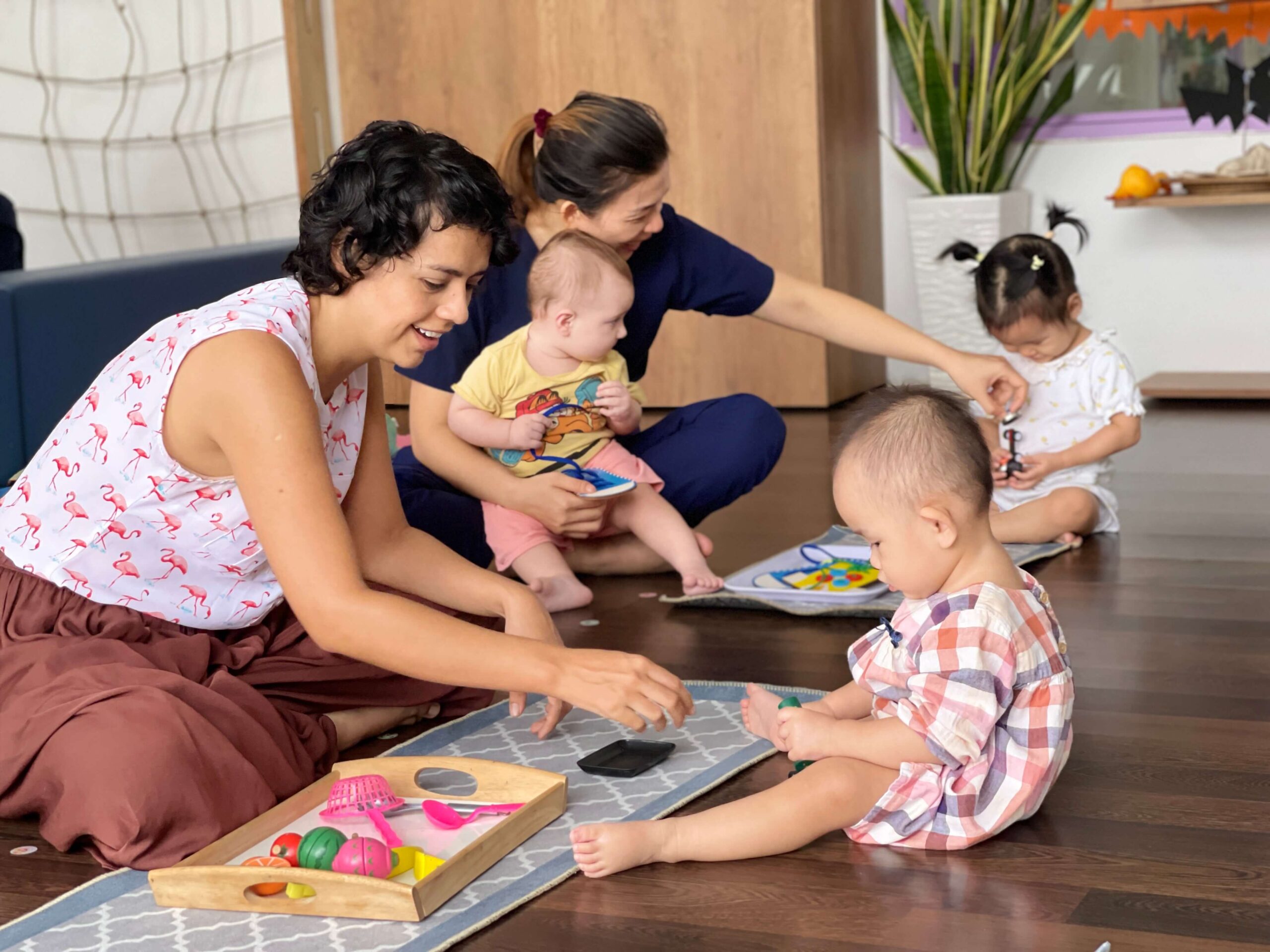
6. Social and Emotional
To support and enhance an infant’s development, teachers engage in regular, nurturing interactions that encourage attachment and social skills. Spend quality time cuddling and holding the infant, as this fosters a sense of security and affection. Play interactive games that promote eye contact and mimicry, allowing the baby to imitate sounds and movements. Encourage exploration of their environment by providing safe spaces for curiosity and autonomy. Use a variety of tones and expressions during communication to help the infant recognize and respond to different emotions. Additionally, we introduce opportunities for social play with peers, which can help develop their ability to share and interact positively with others.
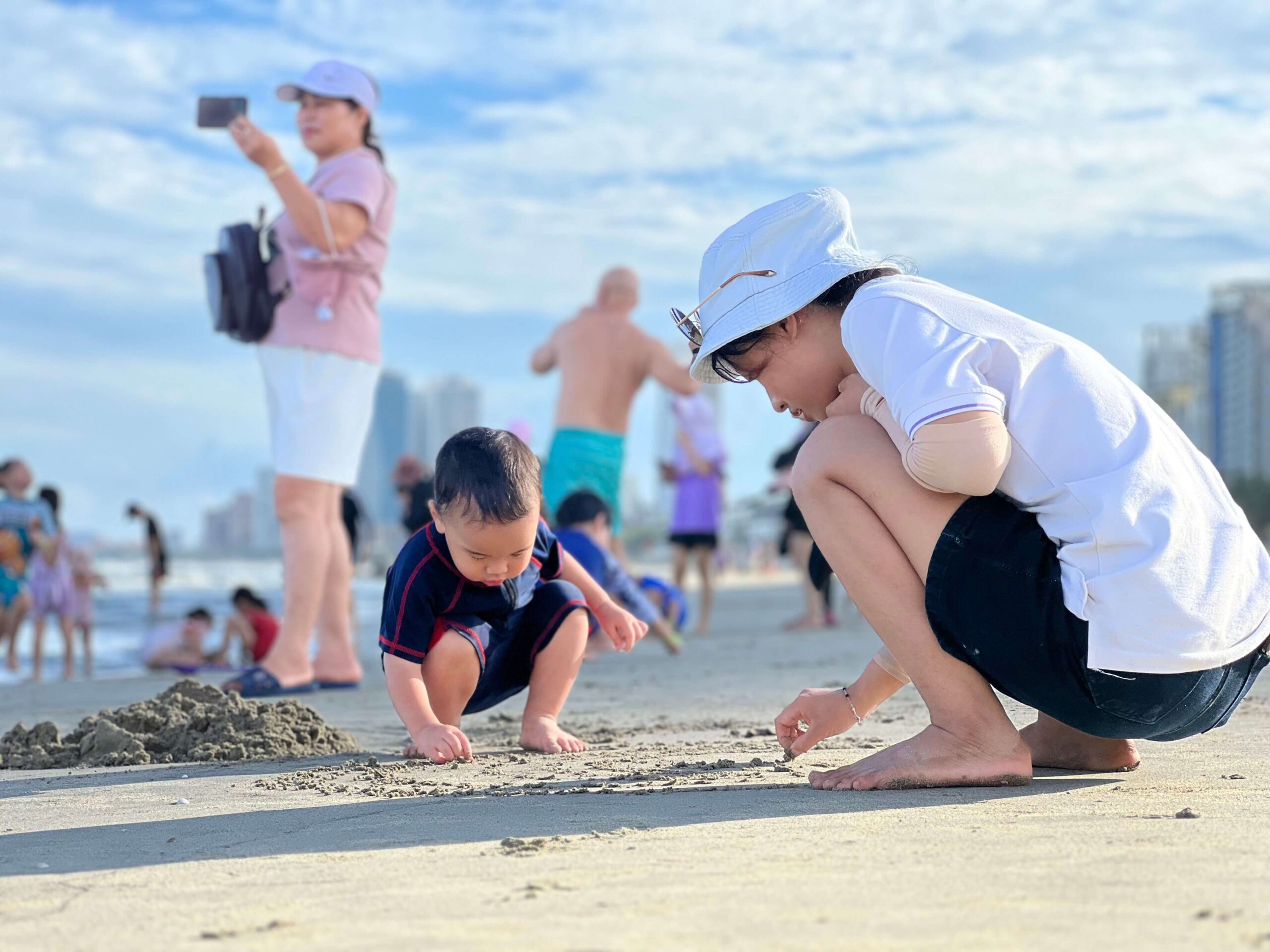
Junior Curriculum
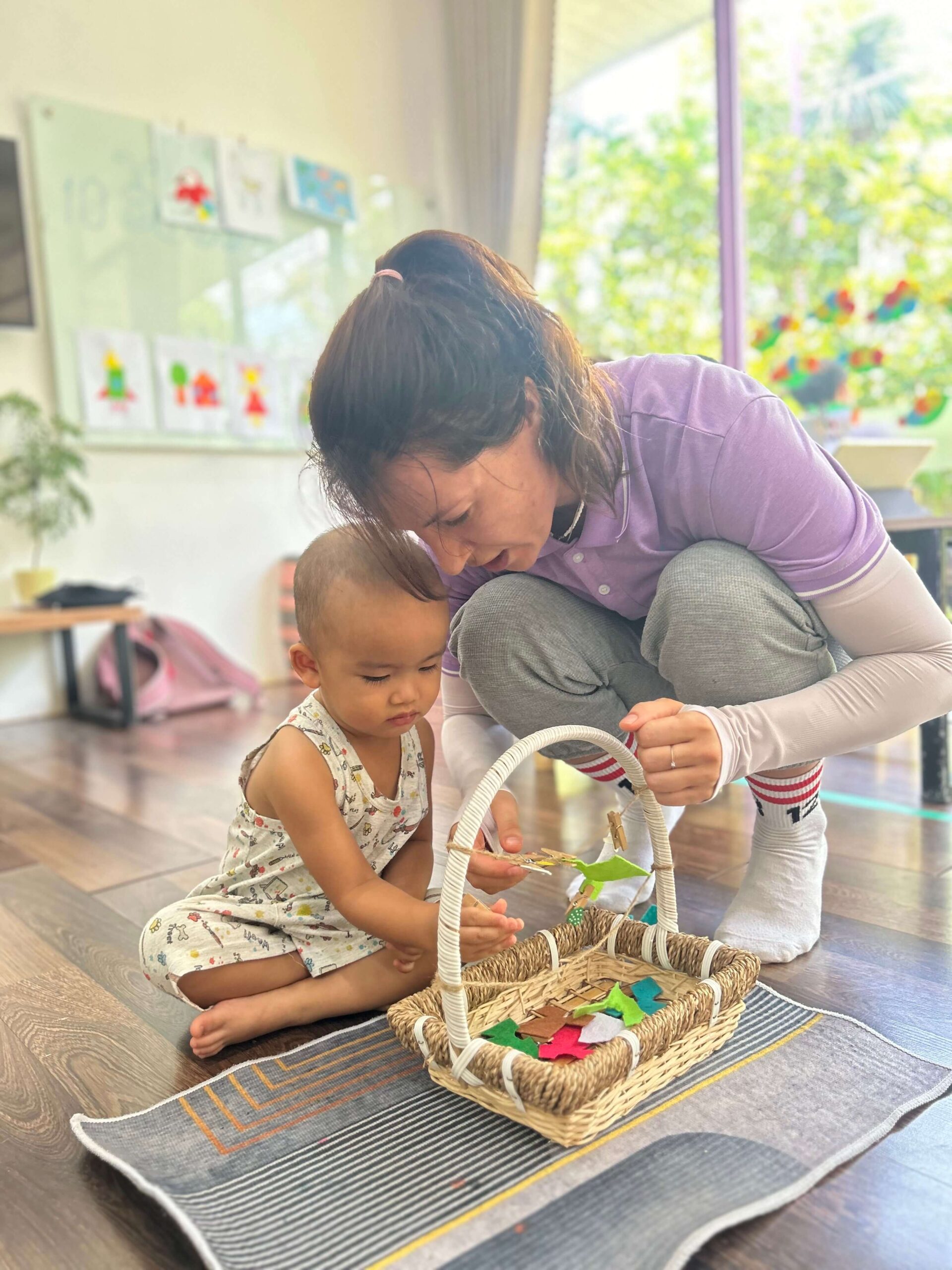
4Life Junior program for toddler ranges from the age of 2 to 3 years when the infant finishes Nursery program. Teachers provide compassion and comfort to the child as they adjust to their new community. The classroom is structured to allow for natural occurring social interaction and to feel like an extension of the home. Adults get down on the child’s level to talk and use calm, simple language. Modeling of desired behaviors and language is of the utmost importance at this age rather than direct instruction.
The program approaches academic preparation in a hands-on format to provide the greatest benefits at this stage of development. Children progress cognitively as they manipulate materials, experiment with gravity and learn the basics of community expectations. Each classroom is equipped with materials that appeal to the child’s senses and aid in the development of gross and fine motor skills. The exercises of practical life allow our youngest students to connect with their new space in a manner they recognize from home (such as sweeping the floor or washing dishes). Children begin learning how to clean up after themselves and develop a sense of order. The toddler environment is filled with language enriching activities such as stories, songs and materials that aid in the development of vocabulary.
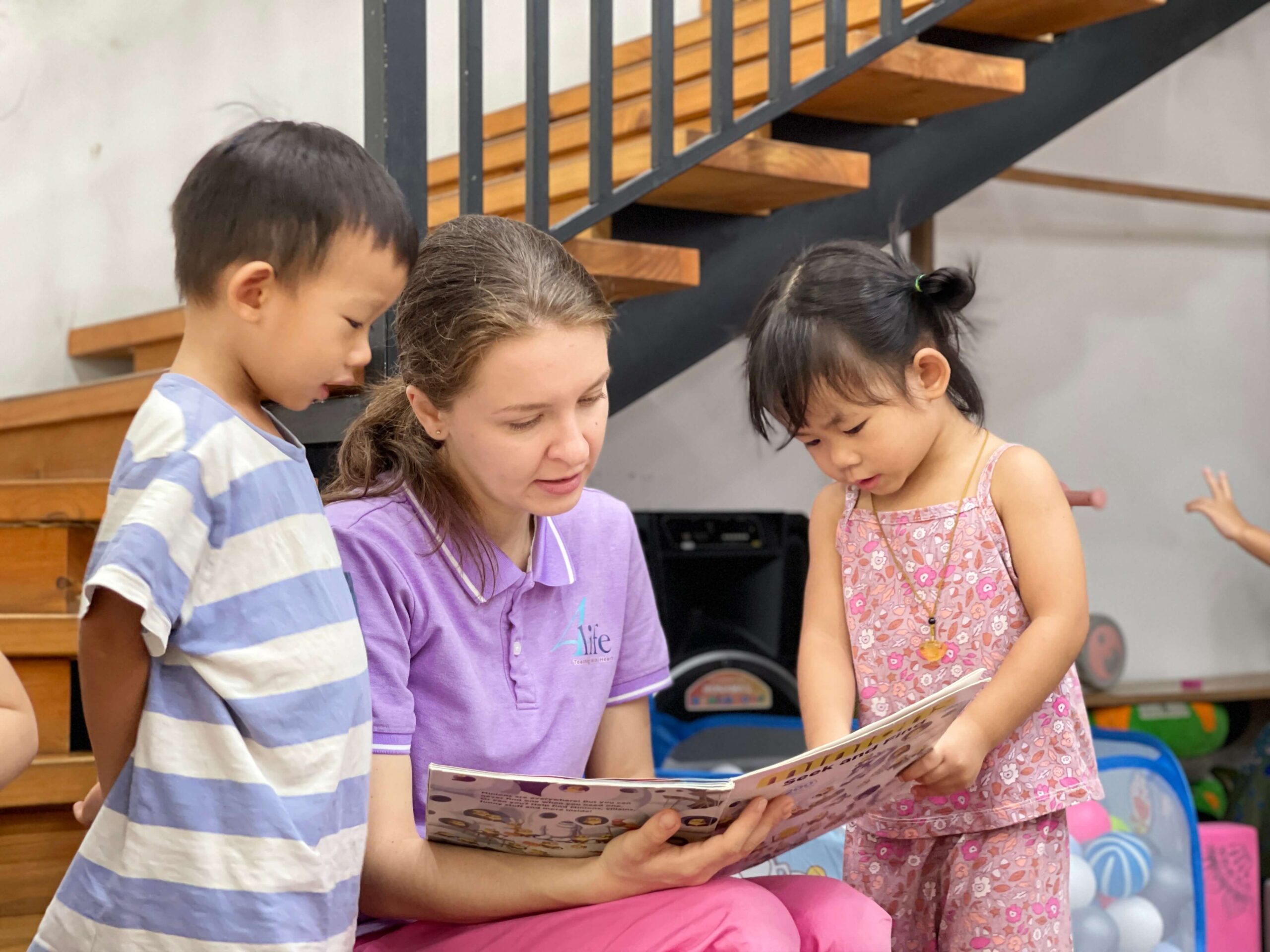
Teachers provide opportunities for the child to express themself with this new vocabulary as well as build awareness of social norms through modeling behaviors in grace and courtesy. Food preparation activities can be found in the environment to aid in the development of motor skills, independence as well as expose children to new foods.
Toilet learning is another huge part of the toddler curriculum. Teachers are trained to look for the signs of readiness in the child and guide them through this new process in a way that is both positive and encouraging. With age-appropriate support, children are interactive participants in their toilet learning process and grow into the empowerment of listening to their bodies.
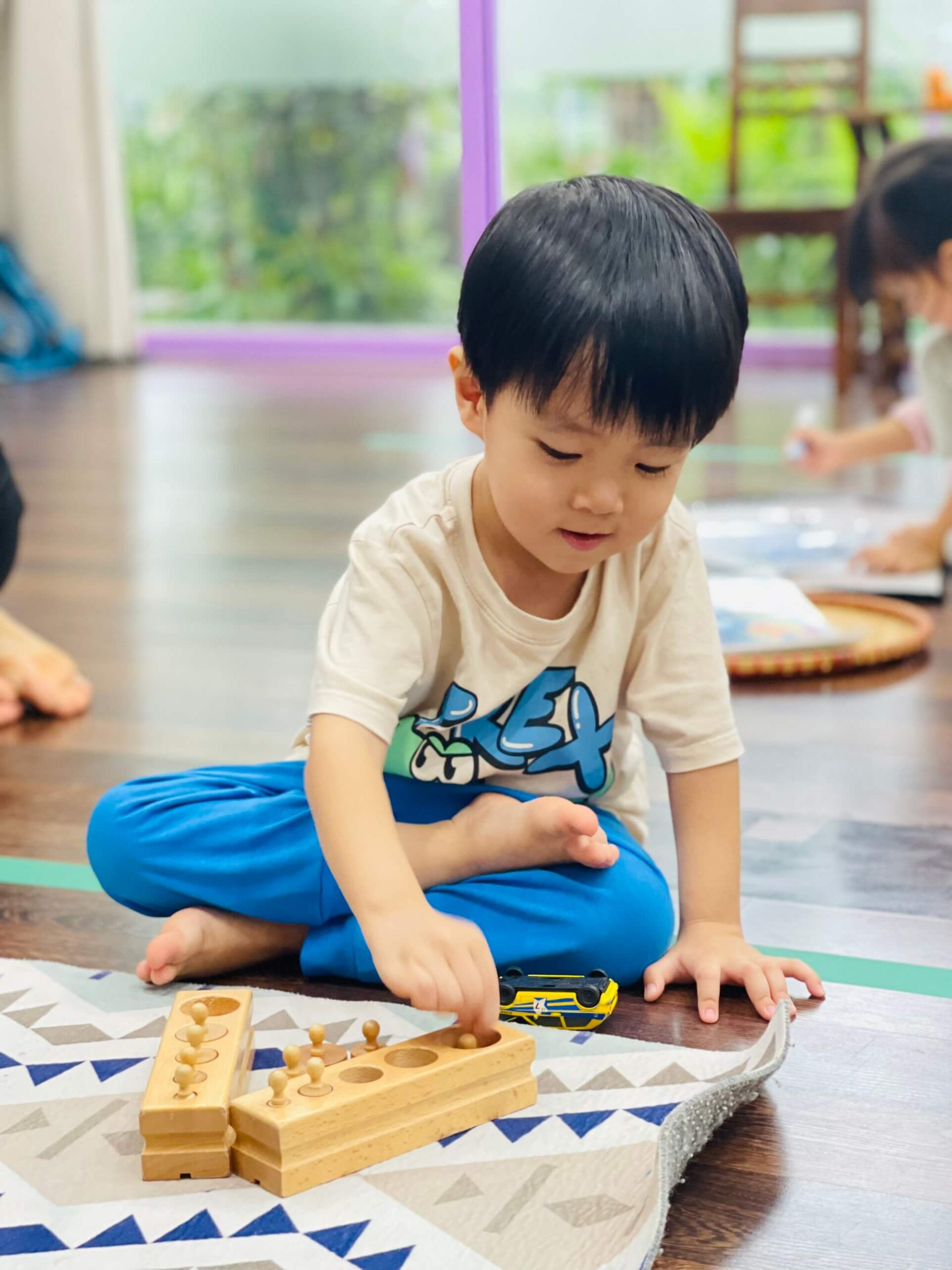
Junior learning basic goals
– Can identify common objects, body parts, and colours by name through tools like Language Cards, Object Boxes, and Colour Boxes, which provide visual and tactile stimuli to enhance vocabulary acquisition and conceptual understanding, fostering early language development and cognitive growth;
– Recognises numerals and counts by rote
Participates in physical activities through activities provide tactile experiences and visual aids to reinforce numerical concepts, fostering early numeracy skills and a foundational understanding of quantity and number recognition;
– Ability to use the pincer grip when writing and drawing;
– Shows self-confidence and interacts well with others;
– Speaks in sentences and expresses thoughts and feelings;
– Distinguishes between sights, smells, tastes and sounds;
– Demonstrates problem-solving skills and shows curiosity.
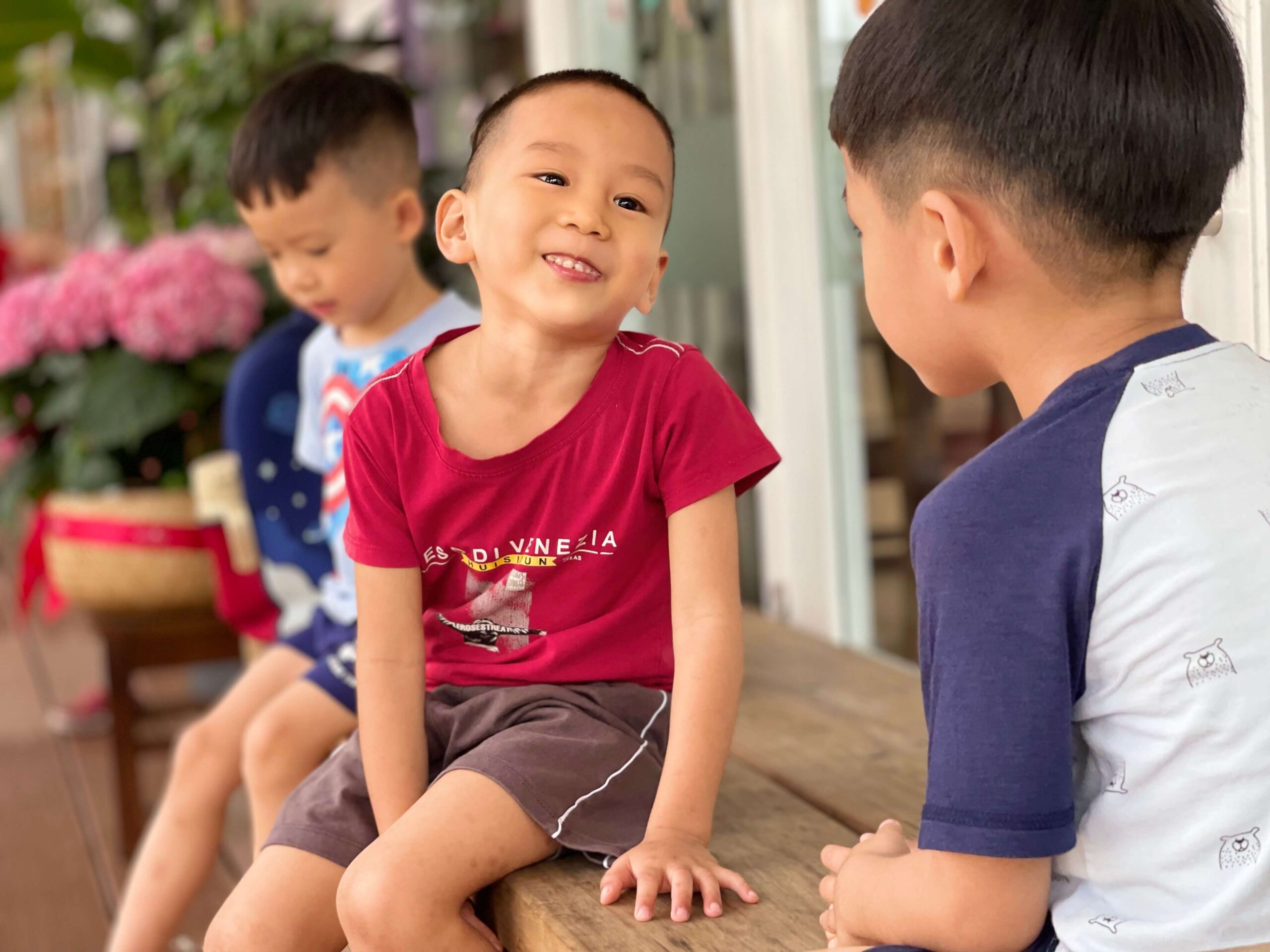
1. Cognitive Development
– Concept formation: Begins to sort mixed collections of objects into categories.
– Exploration: Explores objects in a number of ways using all senses (e.g., Treasure Basket; Heuristic Play Collections…). Purposefully explores objects in a number of ways through shaking, banging, throwing, dropping, etc.
– Sorting and matching involve a range of skills that include connecting objects to corresponding images, pairing identical images together, and associating related pictures. Additionally, it includes sorting items by their shapes, colors, or categories, such as buttons, animals, or beads. These activities not only enhance cognitive abilities but also promote organizational skills and visual recognition.
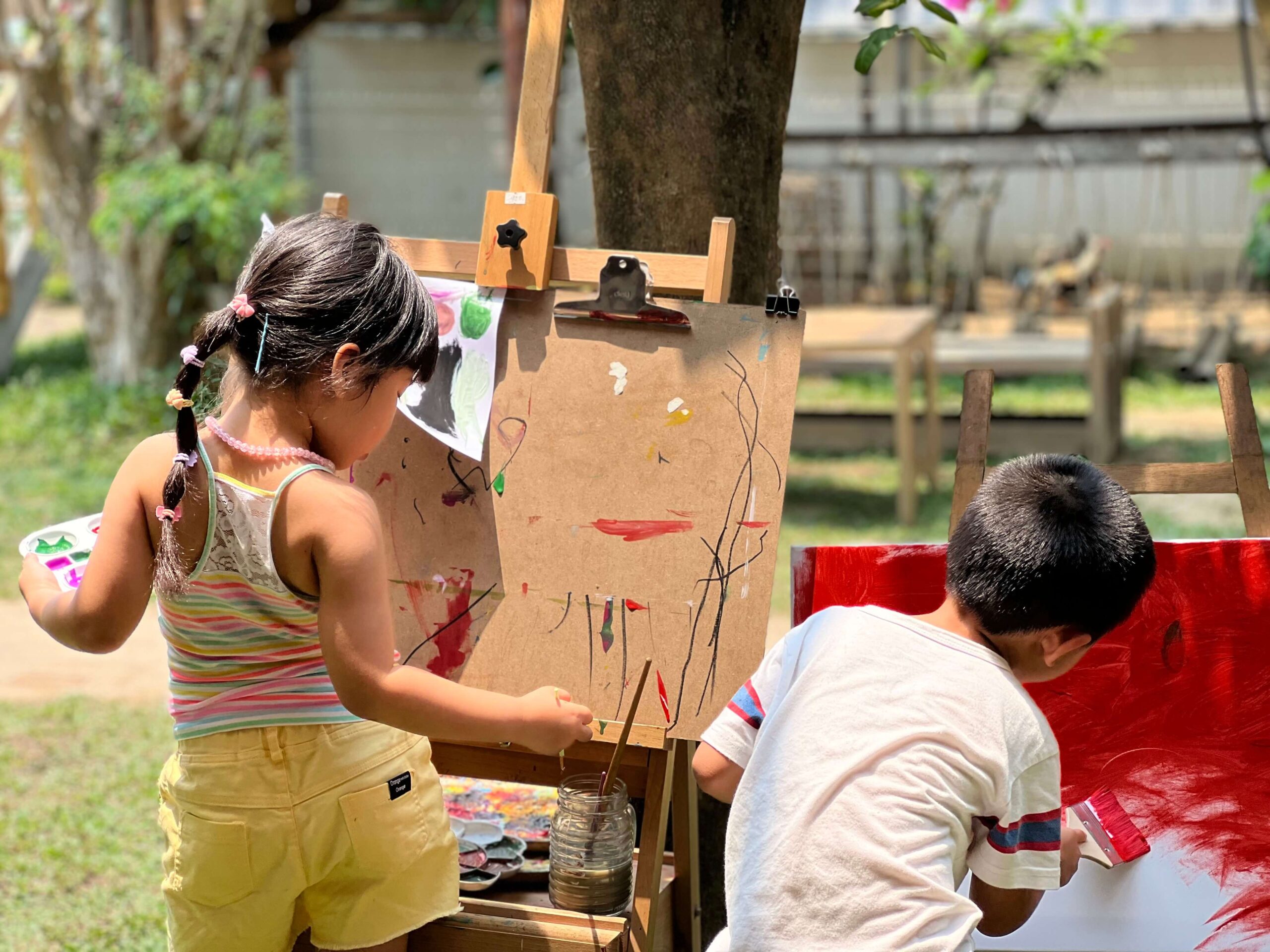
2. Integrated Eye-Hand and Cognitive
Engaging in activities that promote eye-hand coordination and cognitive development is essential for young learners. Simple puzzles featuring three shapes help enhance coordination skills, while stacking color-coded disks on dowels fosters both hand control and color-matching abilities. Additionally, sorting disks of varying sizes not only reinforces these skills but also encourages fine motor development. Placing disks on horizontal dowels aids in developing supinated wrist movement, and working with different-sized balls and ellipsoids on small pegs allows children to explore concepts of size and the relationship between parts and wholes. Activities involving boxes with bins and sliding lids further enhance wrist movement skills and facilitate understanding of object permanence.

3. Language
– Hearing and understanding: Toddler demonstrates their hearing and comprehension skills by pointing to different body parts. They can follow simple instructions that include actions and objects, such as fetching a toy or holding a hand. The child shows genuine interest while listening to stories and rhymes. Additionally, they can identify objects in pictures and books by pointing and can again point to various body parts.
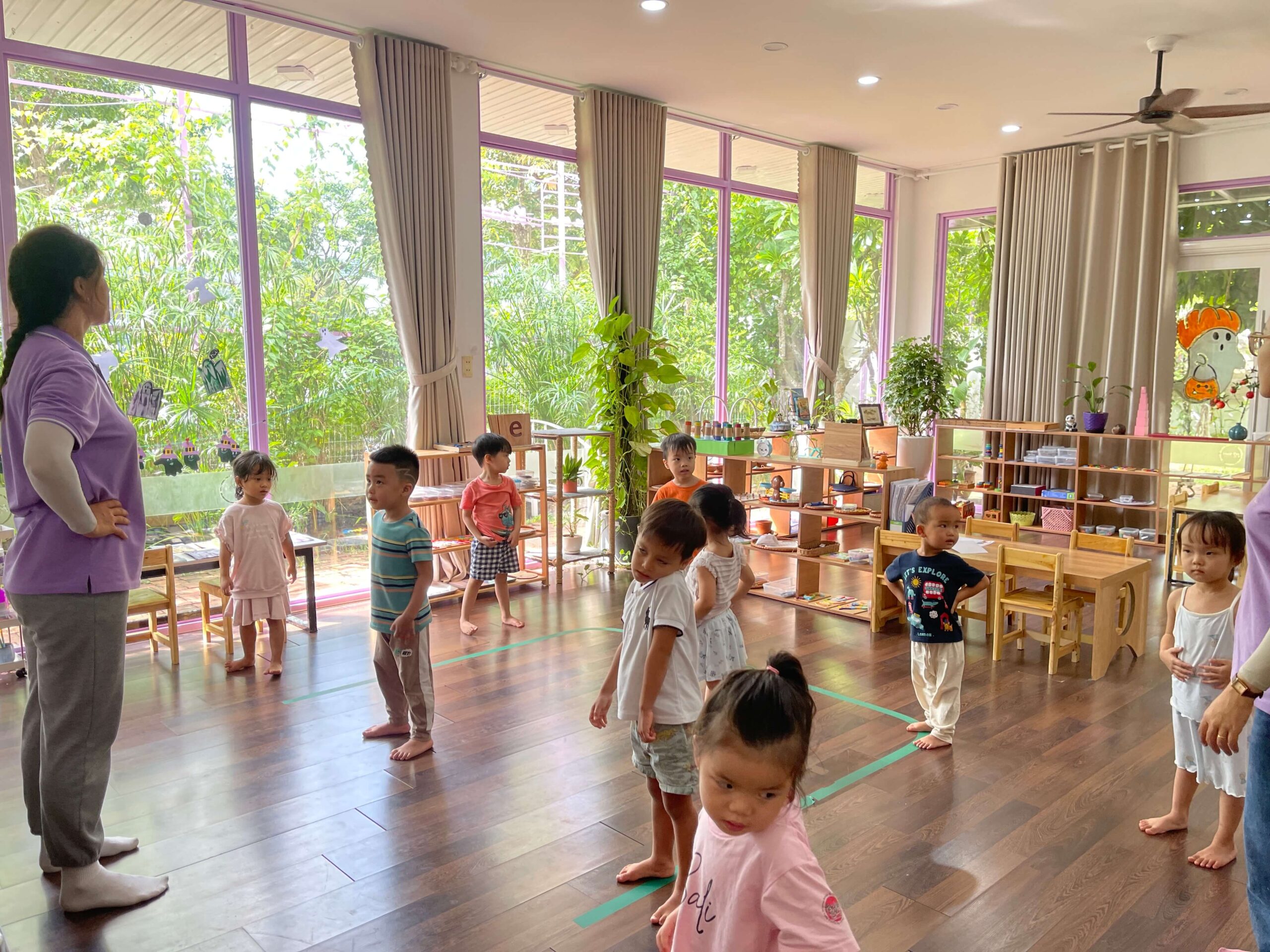
4. Motor Development
Fine motor skills focus on smaller muscle coordination in activities like using utensils or dressing, while gross motor skills involve larger muscles for crawling, walking, and jumping.
– Equilibrium: tasks include walking while holding onto bars or furniture for support, walking independently, and carrying large or heavy objects while climbing stairs to demonstrate maximum effort. This also encompasses running and kicking a ball as part of physical activity.
– The hands collaborate effectively, coordinating their movements for tasks that require skill. They are employed intentionally for various functions and demonstrate a growing level of precision in their actions
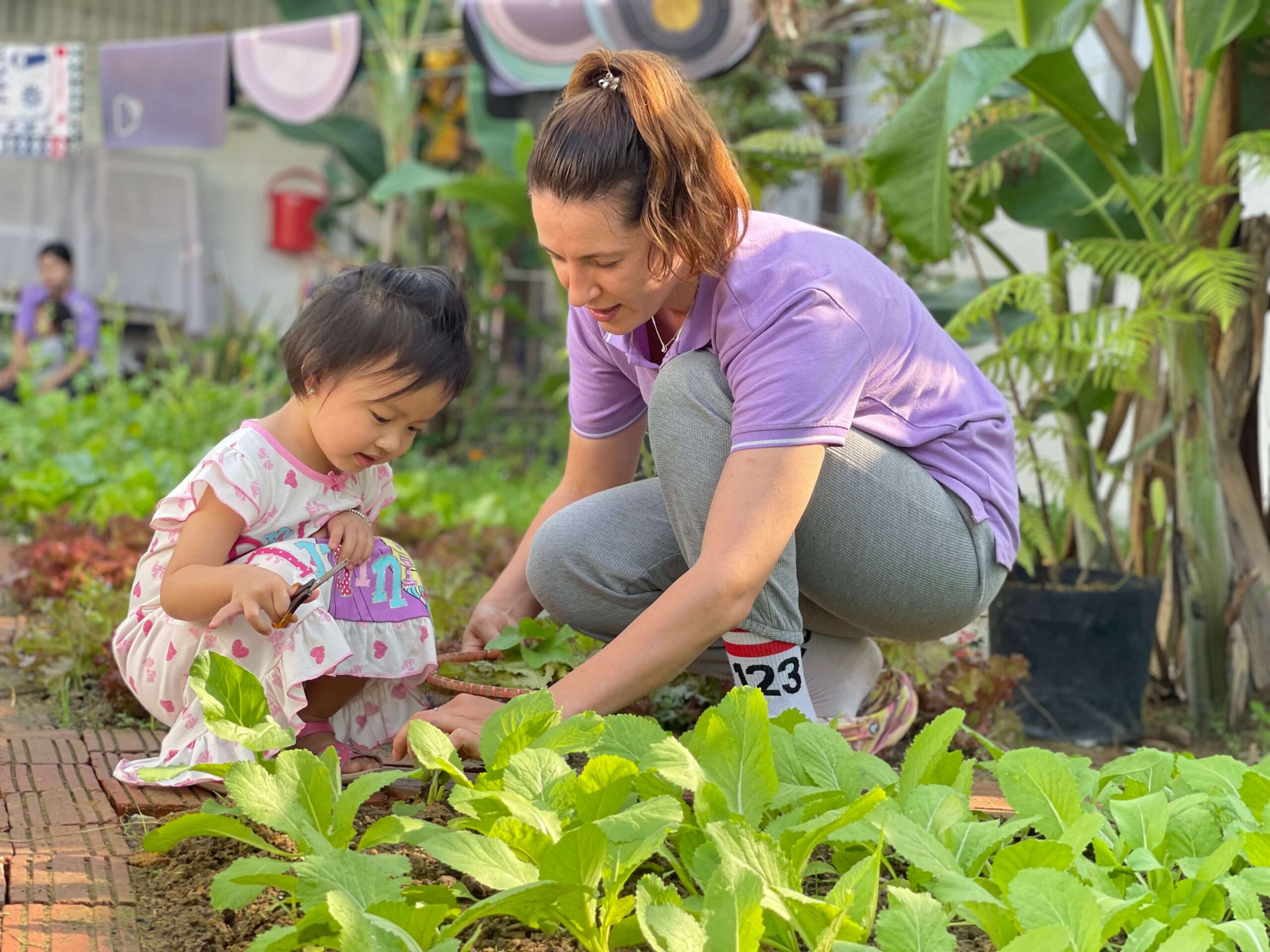
5. Practical Life
– Independently uses fingers to feed themselves and works alongside an adult during mealtime at the weaning table and chair. Demonstrates the ability to use a spoon for eating and can drink from a teaspoon provided by an adult. Also capable of drinking from a cup.
– Engaging in daily living activities with an adult involves working together on various tasks. This includes collaborating in washing dishes, arranging flowers, and folding clothes. Additionally, it encompasses assisting in food preparation, tidying up, setting the table for meals, and clearing the table afterward. There’s also teamwork in sorting and folding laundry, as well as pouring drinks like water and juice.
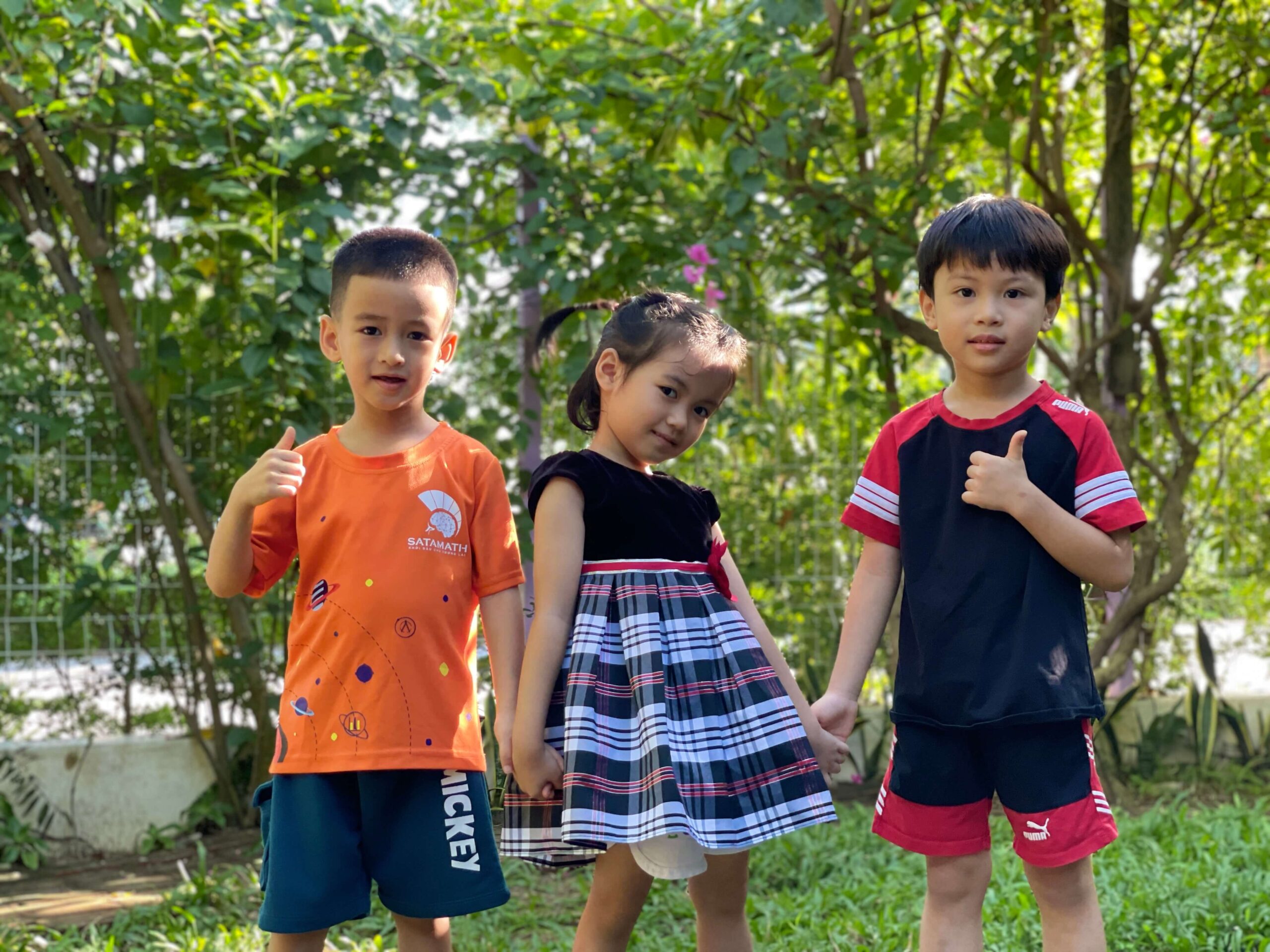
6. Social and Emotional
– Self-Awareness and Emotions: Toddler shows an increasing understanding of themselves as distinct from others. They can recognize their reflection in a mirror and refer to themselves by name. Additionally, they express feelings of anger when interrupted, highlighting their emotional responses and sense of identity.
– During social interactions, toddler experience separation from their parents and begin to make choices about the activities they want to engage in. They not only interact with both peers and adults but also actively participate in group activities. Additionally, they tend to mimic the behavior of those around them, which includes actions seen in songs and various play activities.

7. Art and Environment care
– Artistic abilities encompass a variety of skills, including drawing, working with playdough and clay, and painting. Proficiency in using scissors, threading objects, and engaging in lacing and sewing is also essential. Artists provide representation in their artwork and may explore musical instruments as a form of expression. Additional skills include tearing paper, gluing and pasting materials, and peeling off stickers, all of which contribute to the creative process.
– Taking care of the environment involves a variety of tasks. These include mopping, sweeping, and folding items, as well as wiping up spills. It’s also important to use a dustpan and broom for collecting debris and to dust surfaces regularly. Cleaning windows and mirrors keeps spaces bright, while shoveling is essential for managing snow. Additionally, scrubbing and washing objects ensure cleanliness, and returning materials to their designated shelves helps maintain organization. Plant care and flower arranging add aesthetic appeal and contribute to a healthy environment.
Senior Curriculum
Senior class is the Montessori environment prepared for preschool children from 3 to 6 years of age. Senior is prepared to be homelike, welcoming, aesthetically pleasing and orderly so children come to think of the setting as a ‘mini-community’ where they learn skills they can apply at home and in the wider community. Cooperation, rather than competition, is encouraged.
The ordered Senior environment provides children with structure and predictability, and helps them orient themselves both to the physical environment of the Senior and to the multi-age ‘minicommunity’ within the environment. There is a strong emphasis on children developing the independence, cooperation and skills for daily living that enable each one to become a valued and independent member of the 4Life Community.
The materials in the Senior class are kept on open shelves for easy access by the children. Work sessions last at least three hours without fixed breaks, allowing children to follow their natural rhythms of activity and rest without interruptions.
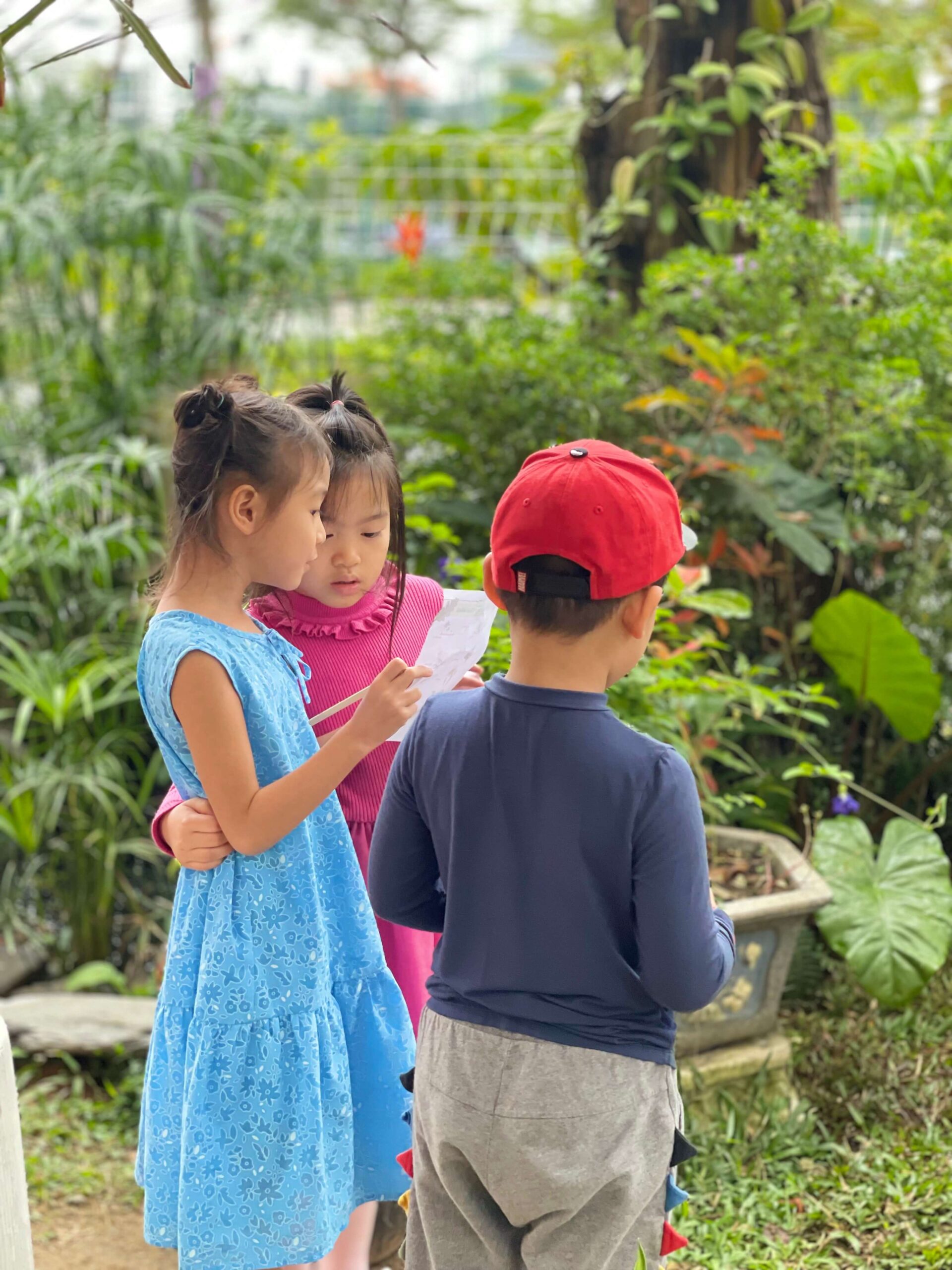
The prepared environment of the Senior incorporates indoor and outdoor spaces. Both spaces complement each other and are available to the children at all times. The majority of Montessori educational materials are commonly displayed in the indoor environment but their use is not restricted to the indoor environment. Practical life activities are part of both the indoor and outdoor environments. Children may also choose to work with materials in the sensorial, mathematics or language areas in the outside environment as long as they are using the materials for the educational purpose for which they have been designed. In addition the outdoor environment includes gardens (both wild and planted), which children care for, and in which they develop a growing awareness of the importance of the natural environment to the well-being of all living things. Activities in the outdoor environment of the Children’s House develop in children an appreciation of the natural world and an awareness of its importance to the wellbeing of all living things including themselves, as well as a beginning understanding of the important role of human beings in caring for the natural environment.

Senior learning basic goals
The resources and activities in the Senior class aim to:
– Develop coordination of movement;
– Foster independence;
– Enhance the ability to make informed decisions;
– Increase the duration a child can maintain deep concentration;
– Refine sensory awareness;
– Encourage exploration;
– Build social skills;
– Improve oral communication skills;
– Strengthen written communication and lay the foundations for joyful reading;
– Cultivate an understanding of mathematical concepts…
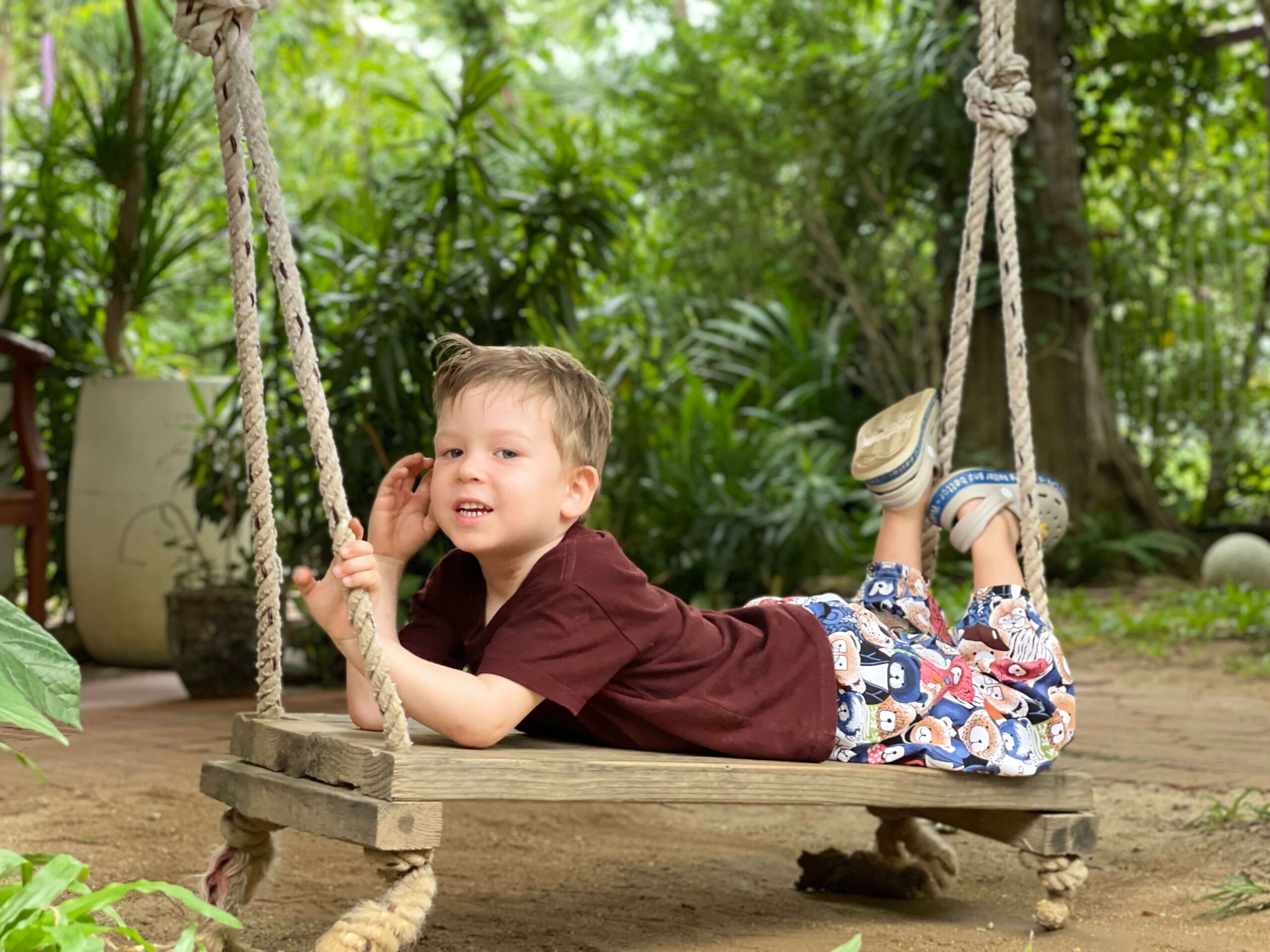
1. Fundamental Life Skills
Learning Fundamental Life Skills, known as Practical Life, is a key component of the 4Life Montessori Kindergarten Programme. This aspect of the curriculum connects the home environment with the Senior class. Children naturally thrive on order and independence, which is expressed through practical life exercises. During these activities, children engage with a variety of materials that help them enhance their:
– Whole body equilibrium and coordination
– Fine motor skills;
– Voluntary control of attention and ability to concentrate;
– Ability to sequence the steps of a task to achieve a goal;
– Everyday living skills.
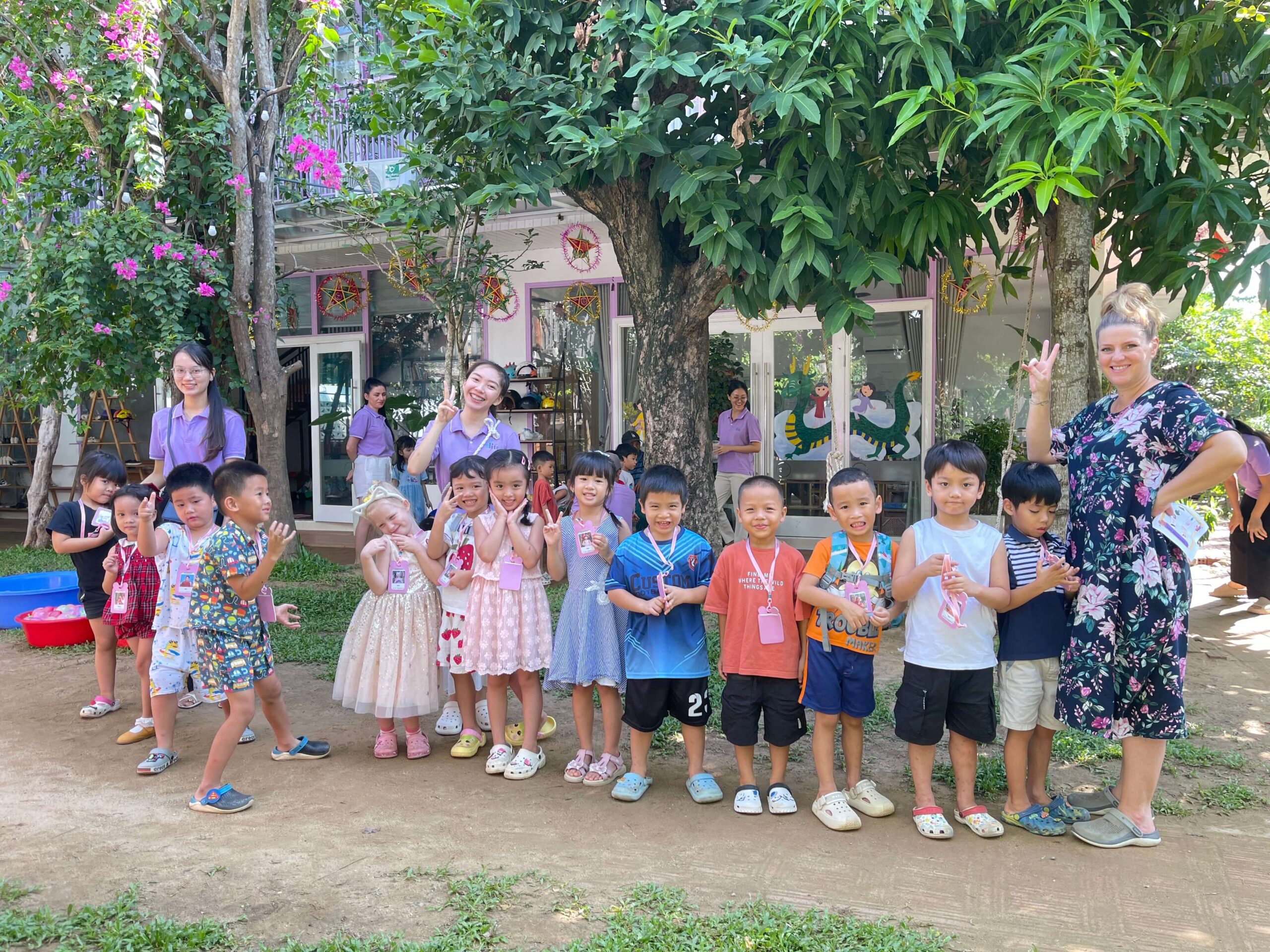
To successfully complete a Practical Life exercise, children must perform precise movements. As they strive for this precision, they also develop their willpower, which includes self-control, the ability to self-regulate, and control over both movement and attention. This foundation is essential for building concentration. When children are allowed to work at their own pace without interruptions, they can gradually increase the time they are able to focus. Completing a work cycle without disturbances often leads to feelings of satisfaction and boosts their confidence in their abilities.
For children aged three to six years in the Senior, Practical Life activities encompass four main areas:
– Control of movement;
– Care of self;
– Care of the environment;
– Grace and courtesy/social relations.
In the Senior class, the skills needed for these exercises are initially developed through a series of ‘transitional’ exercises that focus on practicing ‘preliminary movements.’ These exercises build on the skills learned in the Nursery and Junior Community.
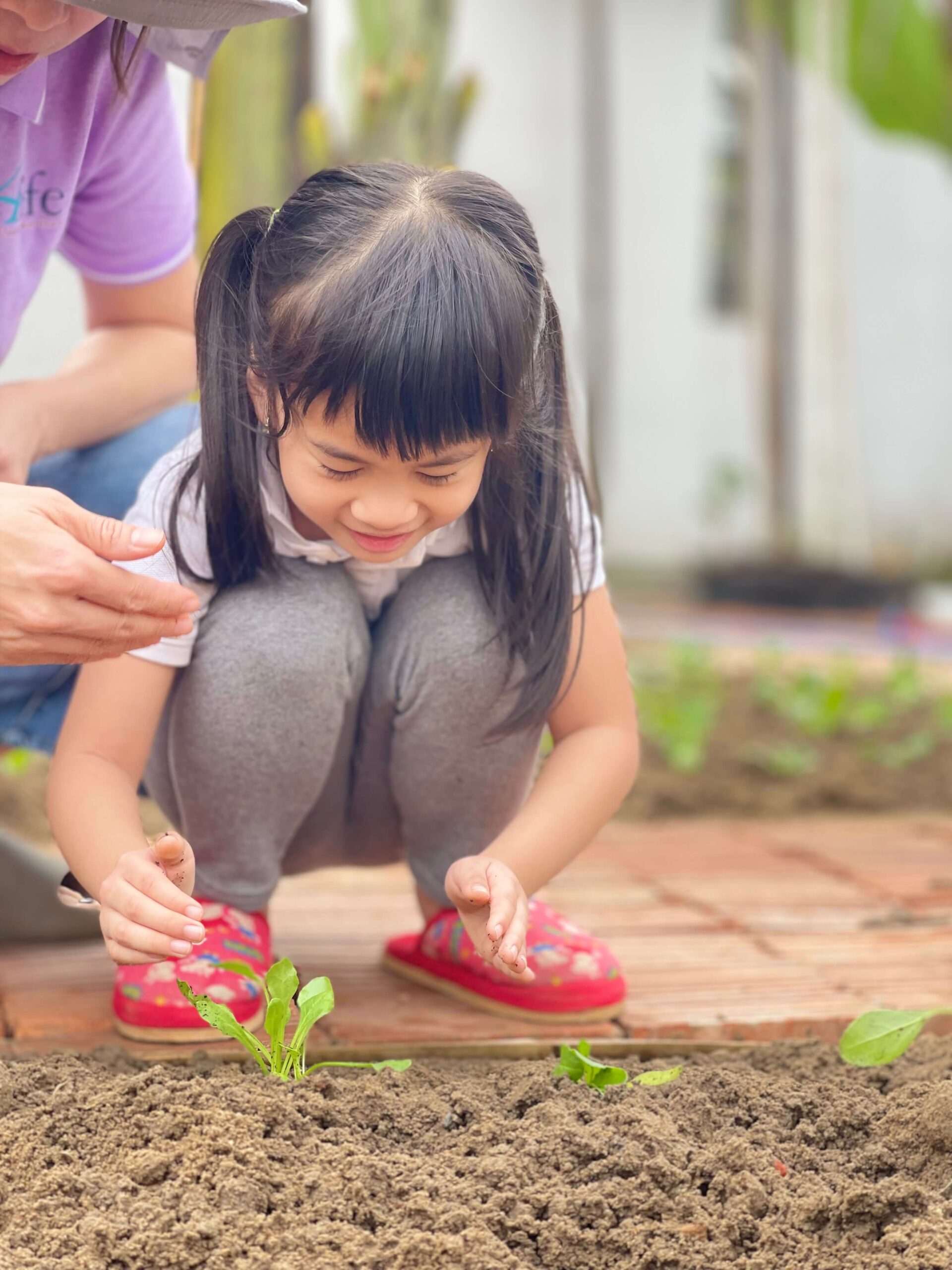
2. Senses Development & Educations
Young children use their senses to explore their environment. Through sensory exploration they receive a myriad of sensory impressions from birth. From about the age of three, the developing human mind, together with the sensitive period of order, naturally strives to discriminate similarities and differences resulting in young children sorting, arranging and classifying the many sensory experiences they have collected so far. The
inventory of sensory experiences they construct at this age becomes a resource they use both for thinking and creating.
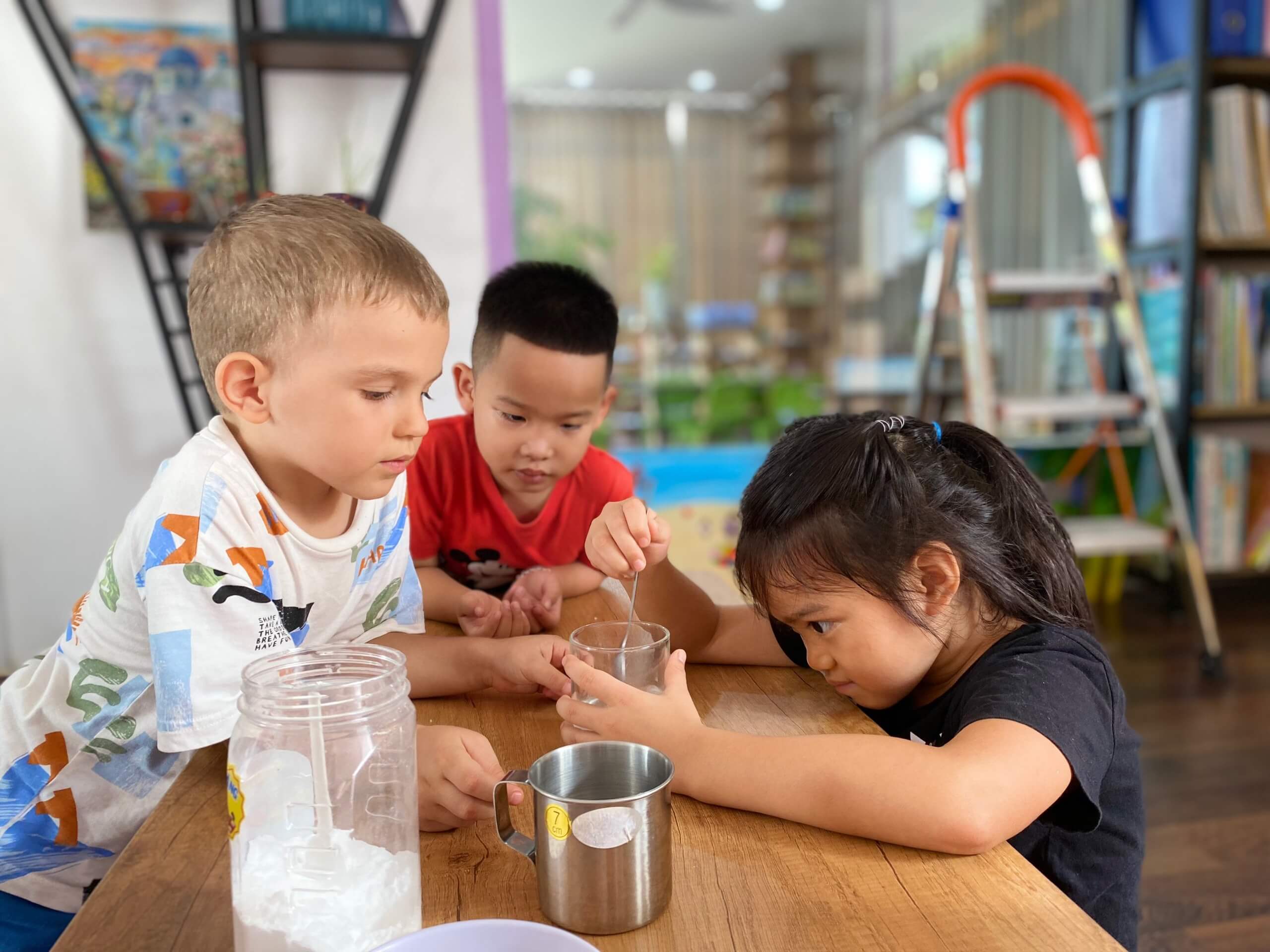
4Life Senior program uses the Montessori materials children use to fine-tune sensory perception and discrimination, the sensorial
materials, are some of the most distinctive and iconic of all the Montessori materials. The sensorial materials are sets of definitive or graded objects designed to precise specifications. Each set isolates one sensory quality only in regular and measurable ways. The qualities isolated by the Montessori sensorial materials include: texture,
colour, shape, dimension, mass, taste, smell, temperature, pitch and intensity of sound. Children are taught a precise vocabulary to talk about the sensory qualities, and their variations, embodied in the materials. They learn these words in contrasting sets, for example, red/blue/yellow; loud/soft; long/short; rough/smooth; triangle/square/circle; cube/sphere. In addition, children are introduced to the superlative and comparative language for example longer/shorter, longest/shortest. This vocabulary then becomes a resource children can use to make more precise meanings about their world. Children use sensorial materials in the exercises of the
senses.
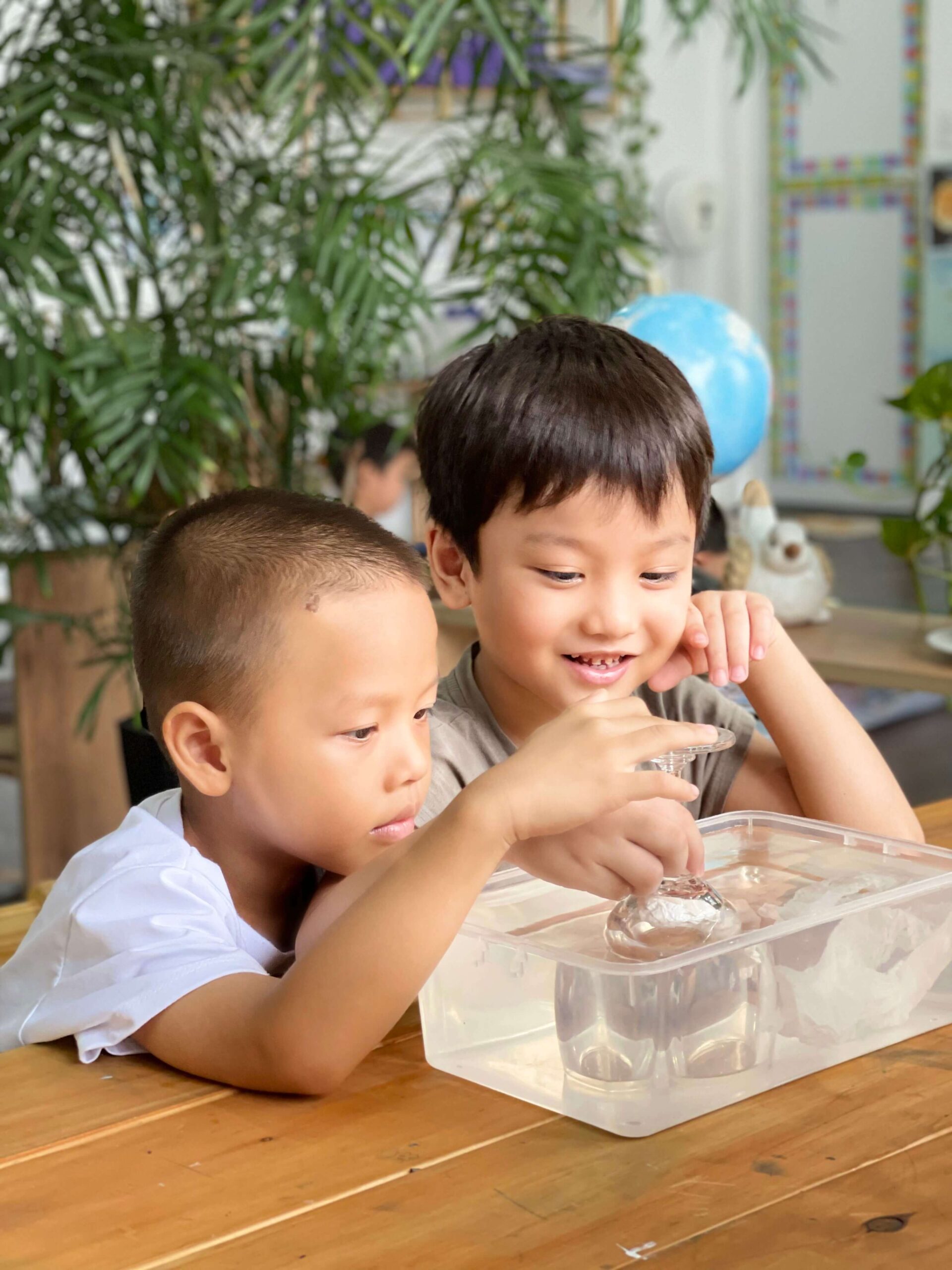
The exercises of the senses provide children with keys to exploring the world, as well as a means to refine perception and to construct a foundation for abstract thinking and creative expression. Initially, the exercises provide children with opportunities to use each sense to distinguish contrasting perceptions. Later, the children use the exercises to discriminate between increasingly fine variations in order to grade the objects in each set. Additionally, the Montessori exercises of the senses support and develop skills and dispositions such as exploration, observation, order, questioning and speculation. These exercises prepare for learning in school subject areas, including mathematics, language, science and geography.
The exercises of the senses include exercises through which children learn to attend to their perceptions and to discriminate between finer and finer variation using the following senses:
- Visual (dimension, colour, shape);
- Tactile (texture, mass, temperature, stereognostic);
- Auditory (pitch, timbre, rhythm, style, intensity of sound);
- Olfactory (smell);
- Gustatory (taste)
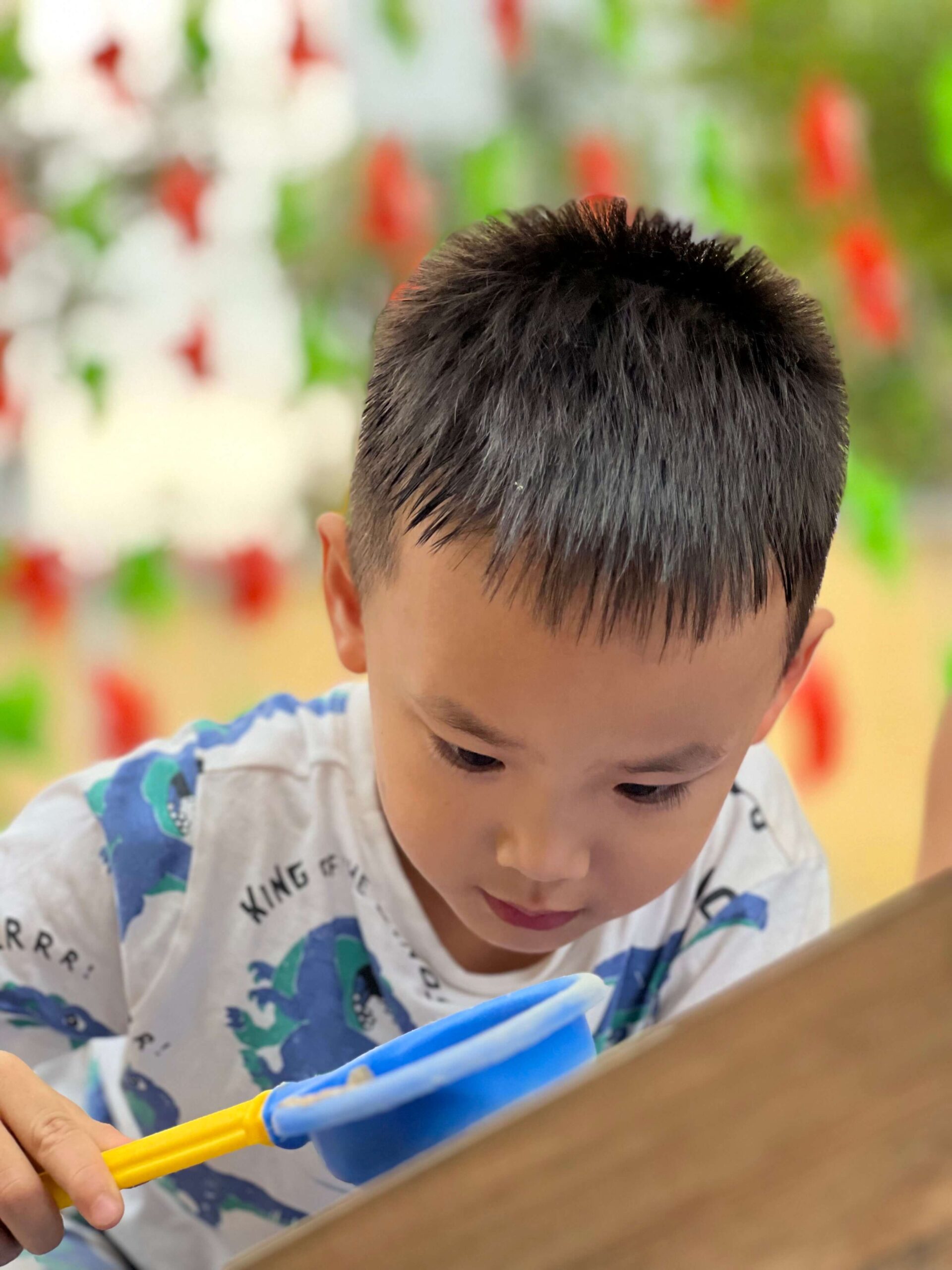
The exercises of the senses help children order sensory impressions in a mental inventory, or classification system, accompanied by a precise vocabulary, which they can use as a resource for thinking and creative expression. These exercises complement children’s work with puzzles and construction materials. It culminates in the children’s ability to apply the skills they gain in sensory discrimination and judgment to phenomena in the wider environment. The use of sensorial materials also develops children’s skills with the precise use of the hand in increasingly exact and controlled movement.
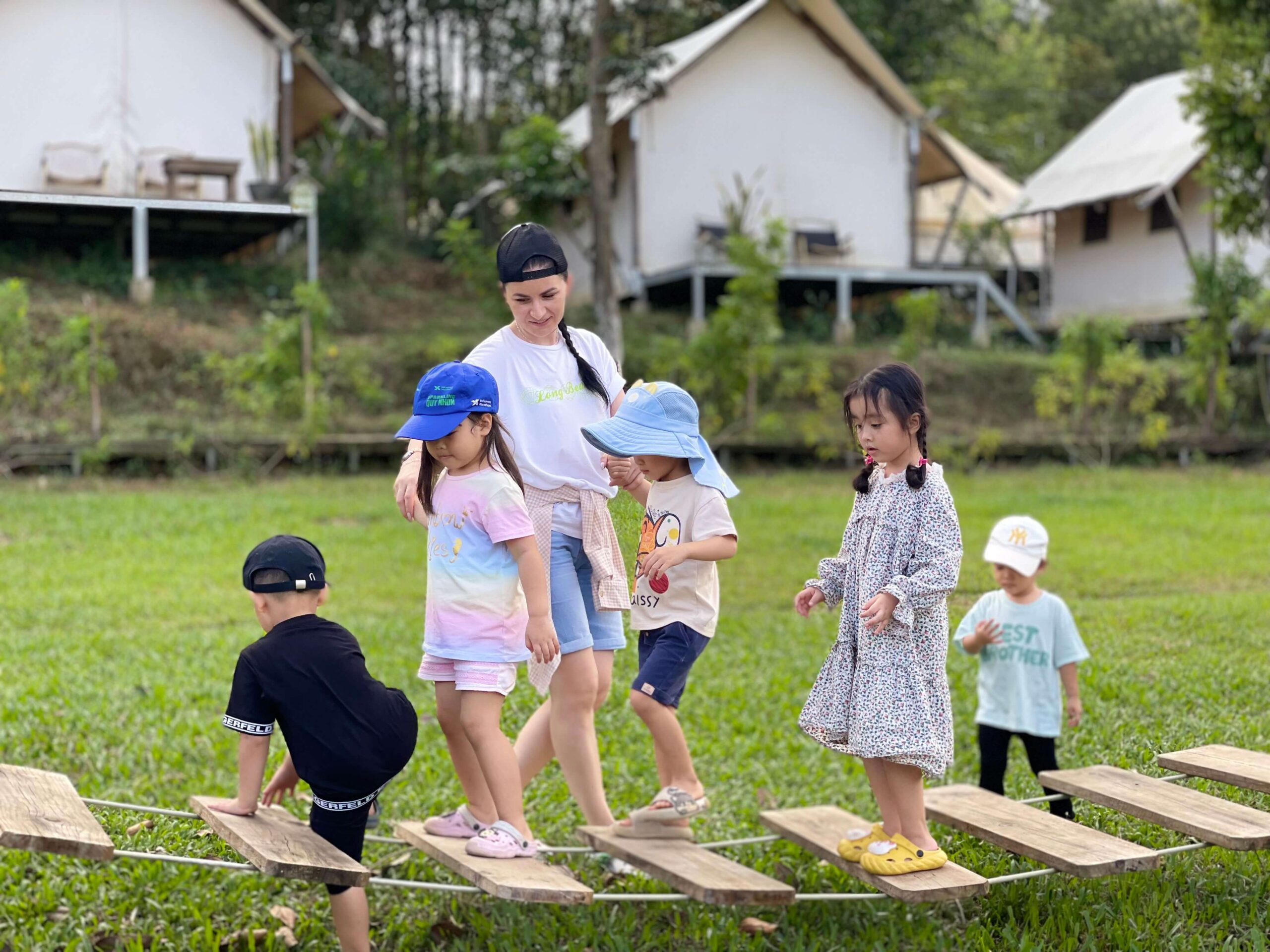
3. Language
4Life Montessori’s early childhood language program has been designed in which all the elements of spoken and written language are taught in an incremental, yet integrated, way. In the Senior class, the spoken language children have been developing since birth is further elaborated and refined through a variety of language enrichment activities that include songs, games, poems, stories and sets of classified picture cards. The multi-age grouping of children means younger children have many opportunities to watch and listen to older children reading both story and factual books.
The first, indirect preparation for mastering written language begins with the exercises of practical life and the exercises of the senses. The exercises of practical life develop fine motor skills and the exercises of the senses prepare children to distinguish between the different sounds of the language and the different shapes of the letters.
When children first work with the letters of the alphabet, they use sandpaper letters as part of activities in which they simultaneously hear the sounds of the letters, and see and trace the shape of the letters. When children know enough letters, they are introduced to a movable alphabet made out of wooden or cardboard letters.
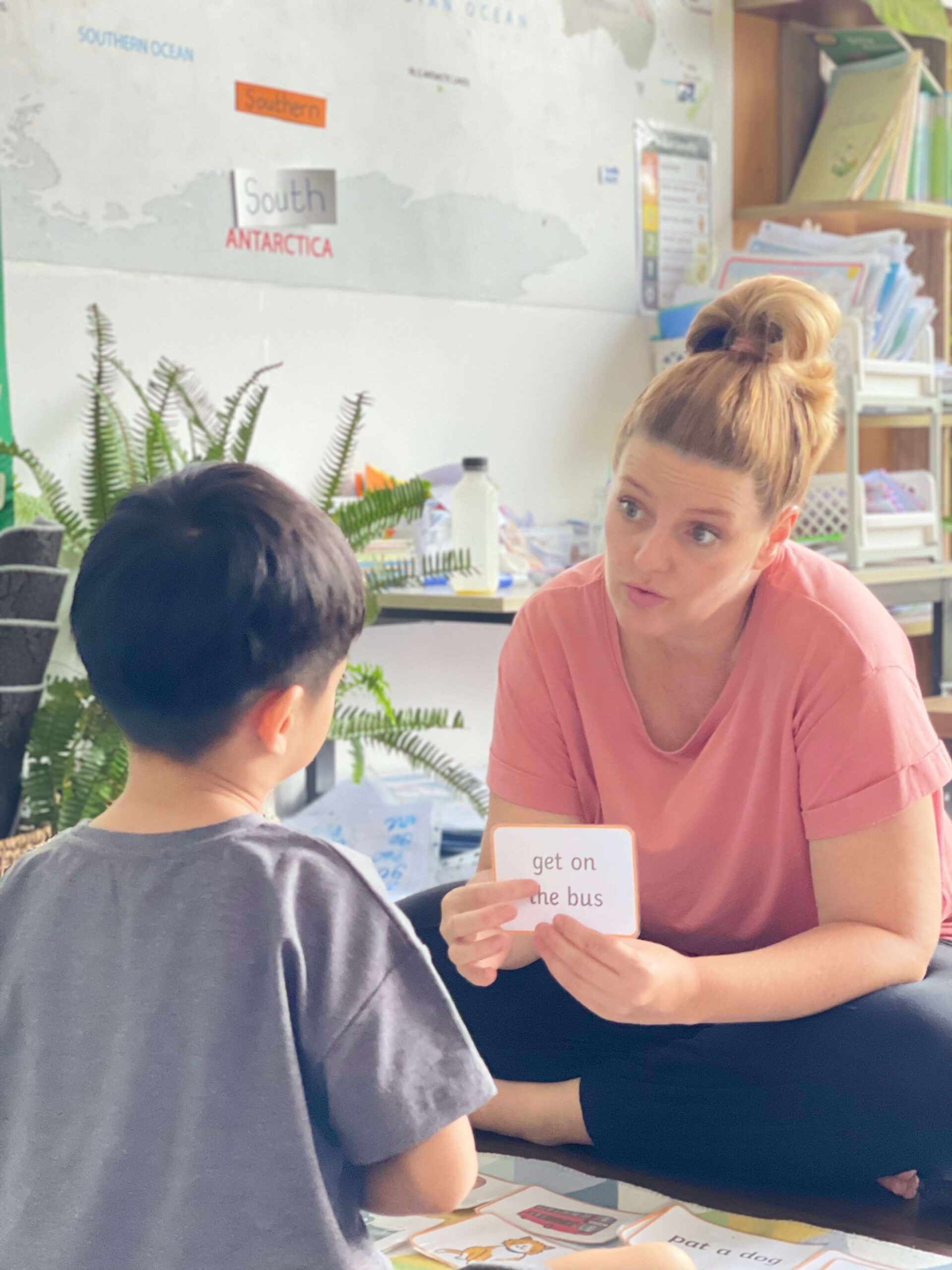
Children use the letters to compose and write down their own words, phrases, sentences and finally stories. Because children are using their own language to compose with the movable alphabet, they may discover that they can read their own writing, especially when the movable alphabet work is accompanied by activities that provide children with structured opportunities for decoding practice. They soon transfer their skills to reading books, both to themselves and others. They are later introduced to word study materials and materials for exploring spelling patterns. To increase reading fluency and comprehension, children work with materials that draw their attention to the grammar patterns of the language.
All elements of the 4Life Montessori language program provide children with a platform for building self-confidence and using language creatively across a variety of modes of communication. Children also have the opportunity to enjoy a wide range of good quality and varied literature, as well as factual and reference books.
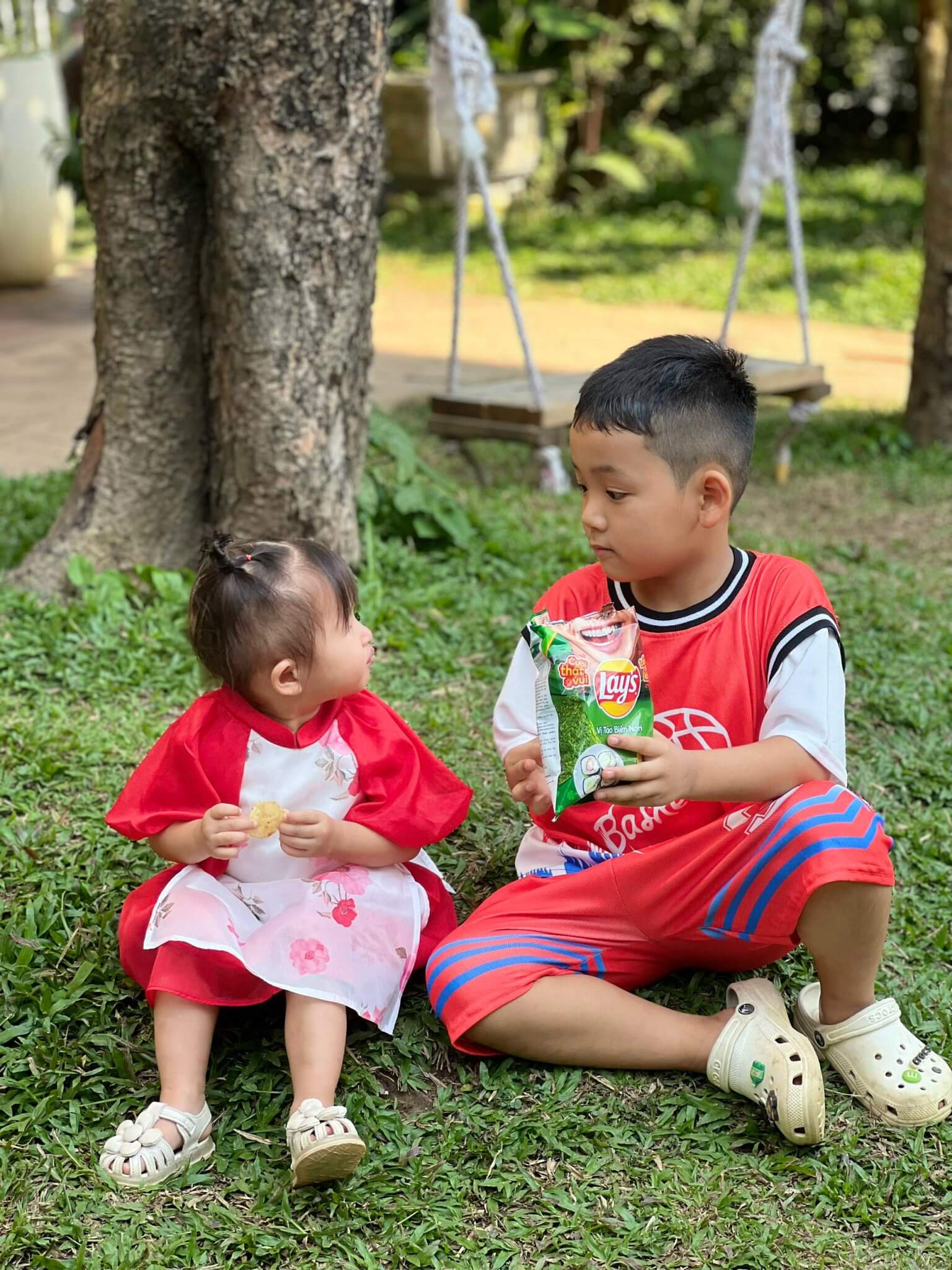
4. Mathematics
The study of mathematics is a reflection of the human tendencies for investigation and orientation, for order and classification, for reasoning and making judgements, and for calculating and measuring. In the 4Life Montessori Senior class, when mathematical concepts are first presented to children, they are embodied in concrete materials.
Mathematics in the Senior class builds on and extends the exercises of practical life and the exercises of the senses, as well as the many mathematical experiences children encounter incidentally in their daily lives, including experiences with:
• visual representation of mathematical concepts
• pattern and order • problem solving
• cardinal and ordinal numbers
• place value • fractions
• operations (addition, subtraction, multiplication, division)
• spatial relations e.g. placement of objects, spatial patterns, one-to-one correspondence of objects and two-dimensional shapes
• measurement e.g. length, mass, time, temperature, volume, perimeter, area
• word problems (addition, subtraction, multiplication, division).
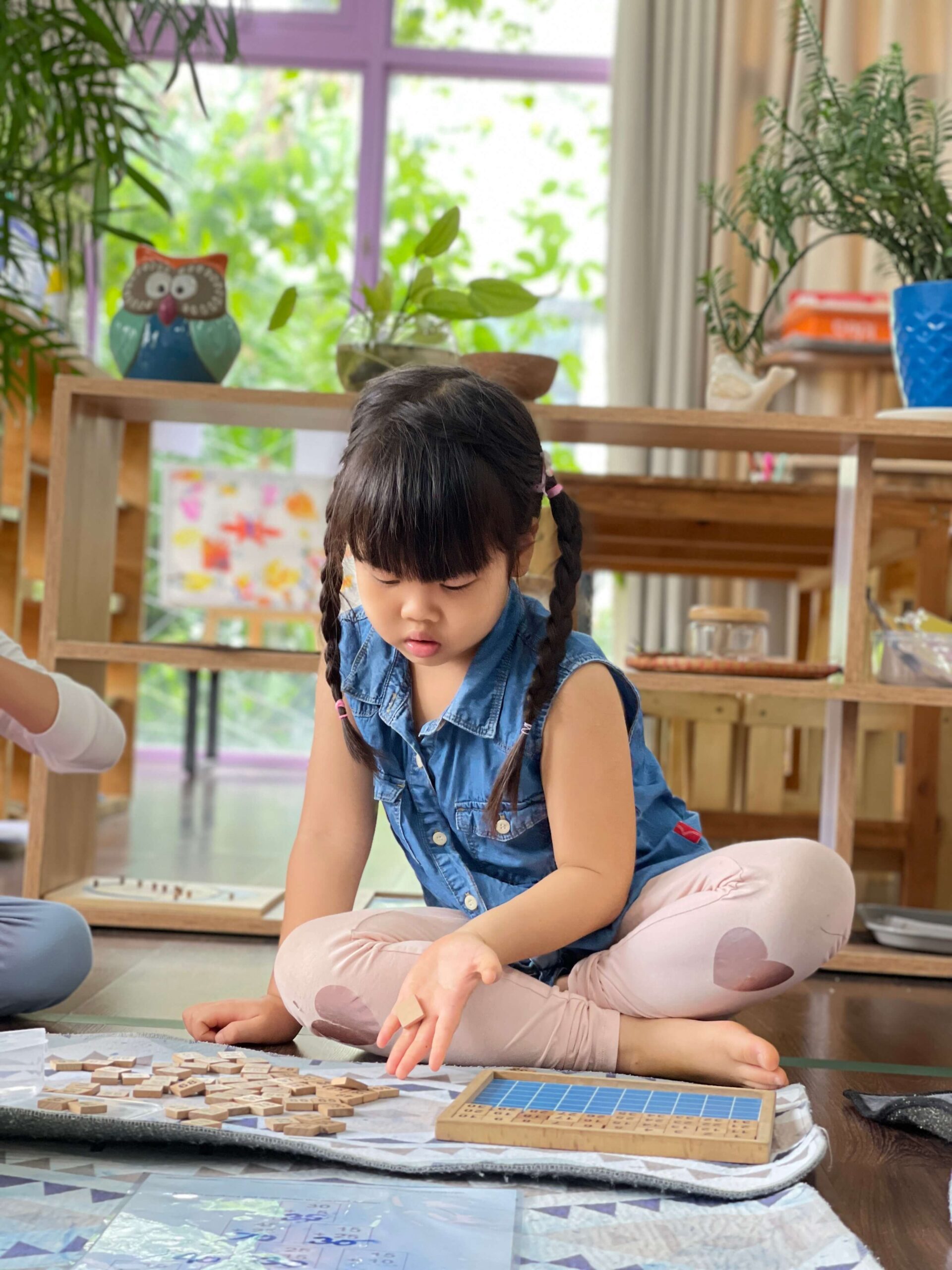
As they work with the exercises of the senses, children are making judgements in relation to distance, dimension, graduation, identity, similarity and sequence. Building on this foundation, the Montessori mathematics materials introduce children to:
• counting (from 1 to 10, 10 to 90, linear 1 to 100 and 1000, and skip-counting as an introduction to multiplication)
• place value to four digits
• number operations (addition, subtraction, multiplication, division).
The base ten number system is represented for children in concrete form using golden beads organised so they vary simultaneously in quantity, size, mass and geometric shape. Children are also given the corresponding symbol for each quantity. In this way, children experience relations between the hierarchies of the system in multiple ways. Using this material in active and enjoyable games, children learn to add, subtract, multiply and divide. This material supports the heightened sensitivity for number children tend to experience around the age of four.
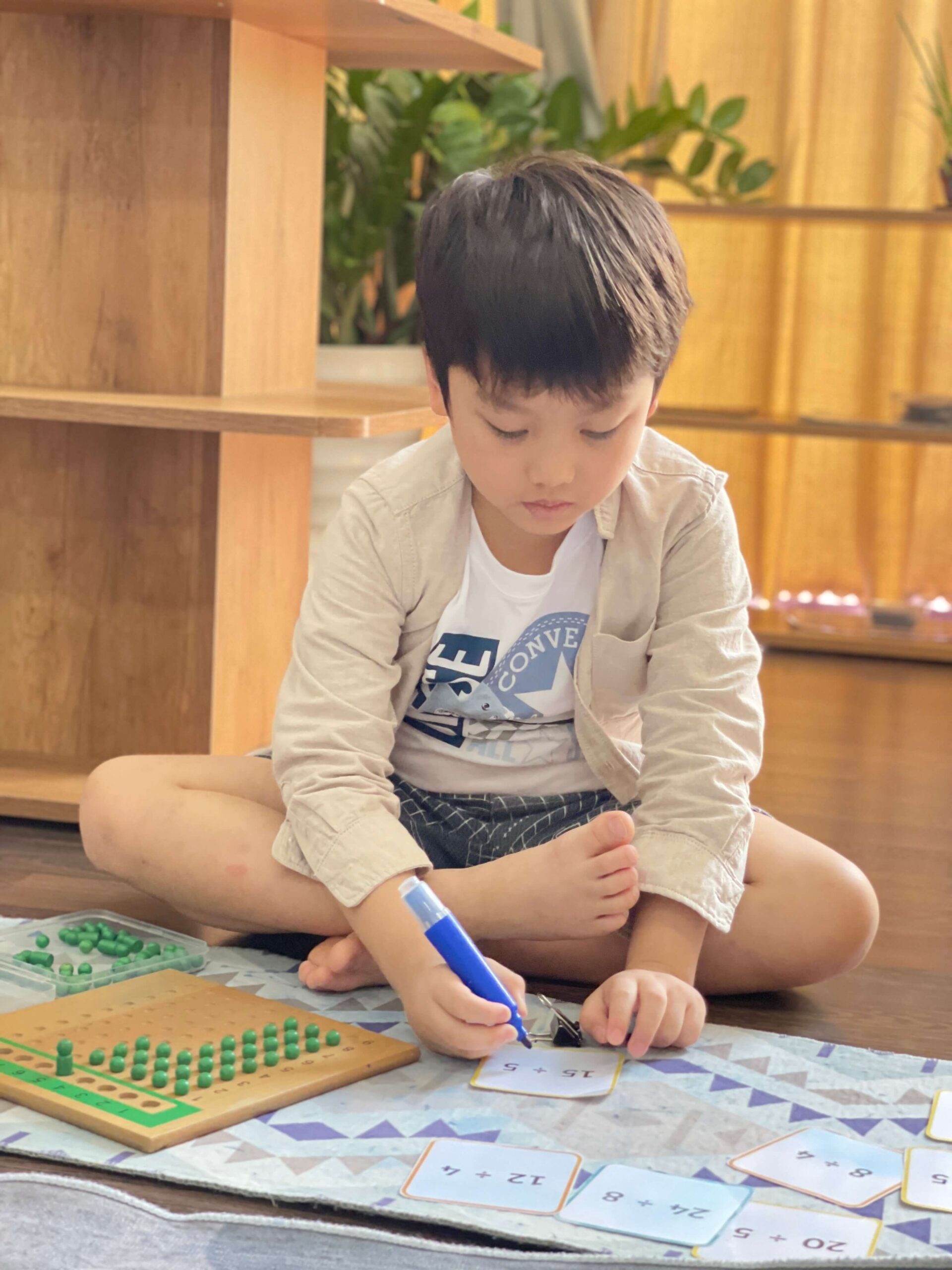
The progression of the Montessori mathematics curriculum in the 4Life Senior class follows a five-step sequence.
4.1. Introduction of Concrete Materials: (The quantity is presented in isolation.)
Concepts are presented in a concrete form children can manipulate. Children are given accurate language to talk about the concrete impressions. Only after they have experienced the concrete material are they given the symbolic mathematical notation.
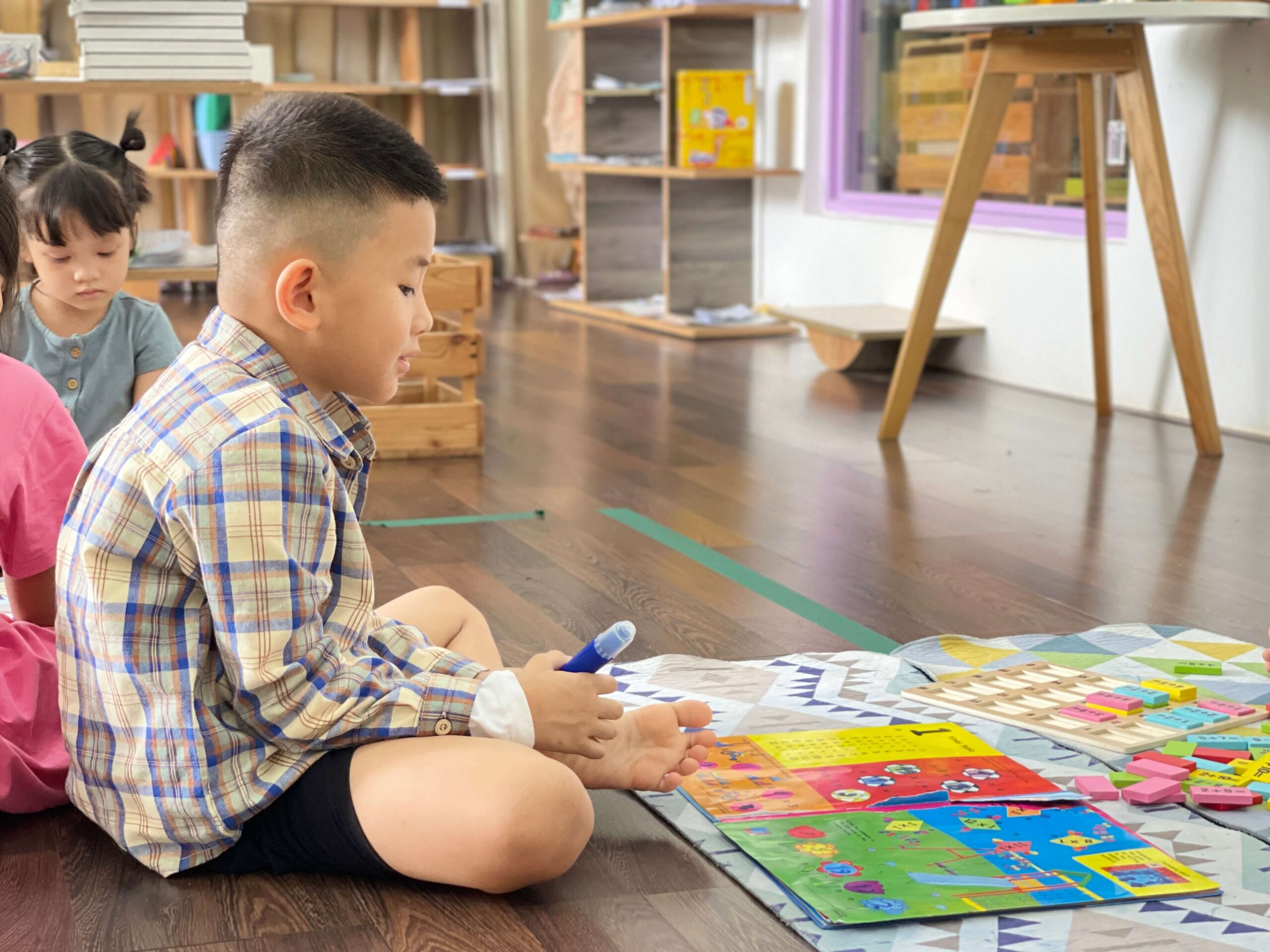
4.2. Introduction of Symbols: (The visually recognised symbols are offered in isolation.)
When the child is comfortable with the concrete representation and the oral language, mathematical
symbols are introduced.
4.3. Association of the Concrete with the Symbols: (Accurate language is the link.)
Only after the child has completed the first two steps are the concrete materials and symbols combined.
4.4. Practice
After being presented with new information children need the opportunity for repetition. Children are offered a way to practise using and remembering this new knowledge and integrating it with what is already known. They have the opportunity to build and consolidate the knowledge through use of the materials, until it becomes automatic.
4.5. Self Assessment
Children are given exercises to affirm or verify their own understanding and knowledge, and to establish whether they are ready for the next exercise.

5. Cultural Subjects: Science, Geography and History
Children enter the 4Life Montessori Senior class when their interest in observing natural and social phenomena is at its peak. They are in the process of building a framework for classifying the features of the world around them. The exercises of the senses develop and refine children’s powers of observation and sensory perception. Children
learn to appreciate the natural world and social world through their senses.
Activities that provide children with experience of the natural and social world are presented in the same integrated way as all Montessori activities. Knowledge is presented to children in concrete form they can manipulate in purposeful ways. Activities allow for freedom of choice and repetition. Lessons can be given
individually, or in small or large groups.
A systematic approach to the study of nature and society in the Senior program lays the foundation for Cosmic Education, which is the major focus of studies for children aged from six to twelve years later.

6. Creative Arts
6.1 Music
In 4Life Montessori early childhood settings music is integrated into the environment and the curriculum. It is not treated as something separate taught only by music experts. It is a form of human expression open to everyone.
In 4Life Senior program, children are introduced to four parallel series of music activities and exercises in each of the following areas:
• singing
• music appreciation
• music literacy (pitch and notation) with the Montessori bells
• rhythm (notation)
• playing of instruments
The music materials in 4Life Montessori early childhood settings have the following features:
• They are always available for the children to use when they choose
• They are prepared so children can use them independently.
• They allow for repetition.
• They are designed to lead to concentration, perseverance, success and confidence.
• They are an integral and constant part of the environment.
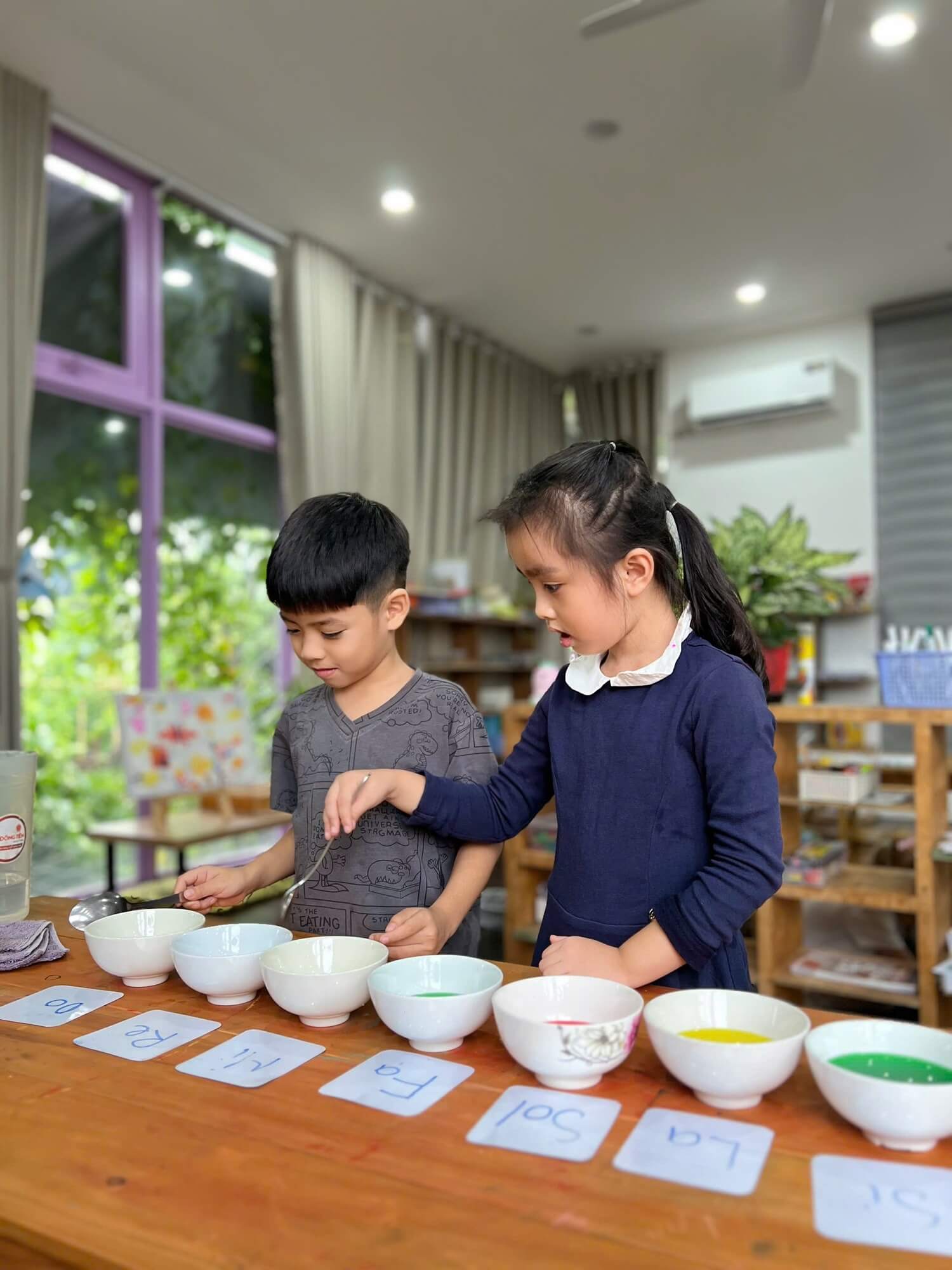
6.2 Visual Arts
Artistic expression was considered by Dr Montessori to be one of the fundamental needs of humans. In particular, she encouraged children to draw. She felt that if children have fine motor control of the hand, learned through the exercises of practical life, combined with trained skills in perception, learned through the exercises of the senses, they would be able to create visual art works of a high quality.
We observed that during periods of creative drawing and design work children concentrate ‘deeply and wholly’ with their ‘entire intellect at work’. We describes the process in the following way:
– To confer the gift of drawing, we must create an eye that sees, a hand that obeys, a soul that feels; and in this task the whole of life must cooperate.
– Art appreciation is also an important aspect of Montessori early childhood settings. By looking at the artworks of others, children learn that it is possible to create different and unique works while using knowledge, skill and techniques developed by others.
Art is integrated into the 4Life Montessori programes in ways that include the following:
• the exercises of practical life and the senses are extended into a range of self expression activities, including
work with clay, collage, chalk, paint, charcoal, crayon, oil pastel, cutting, soft wire, weaving and printing
• written language work, including creative writing and poetry, is illustrated by the children.
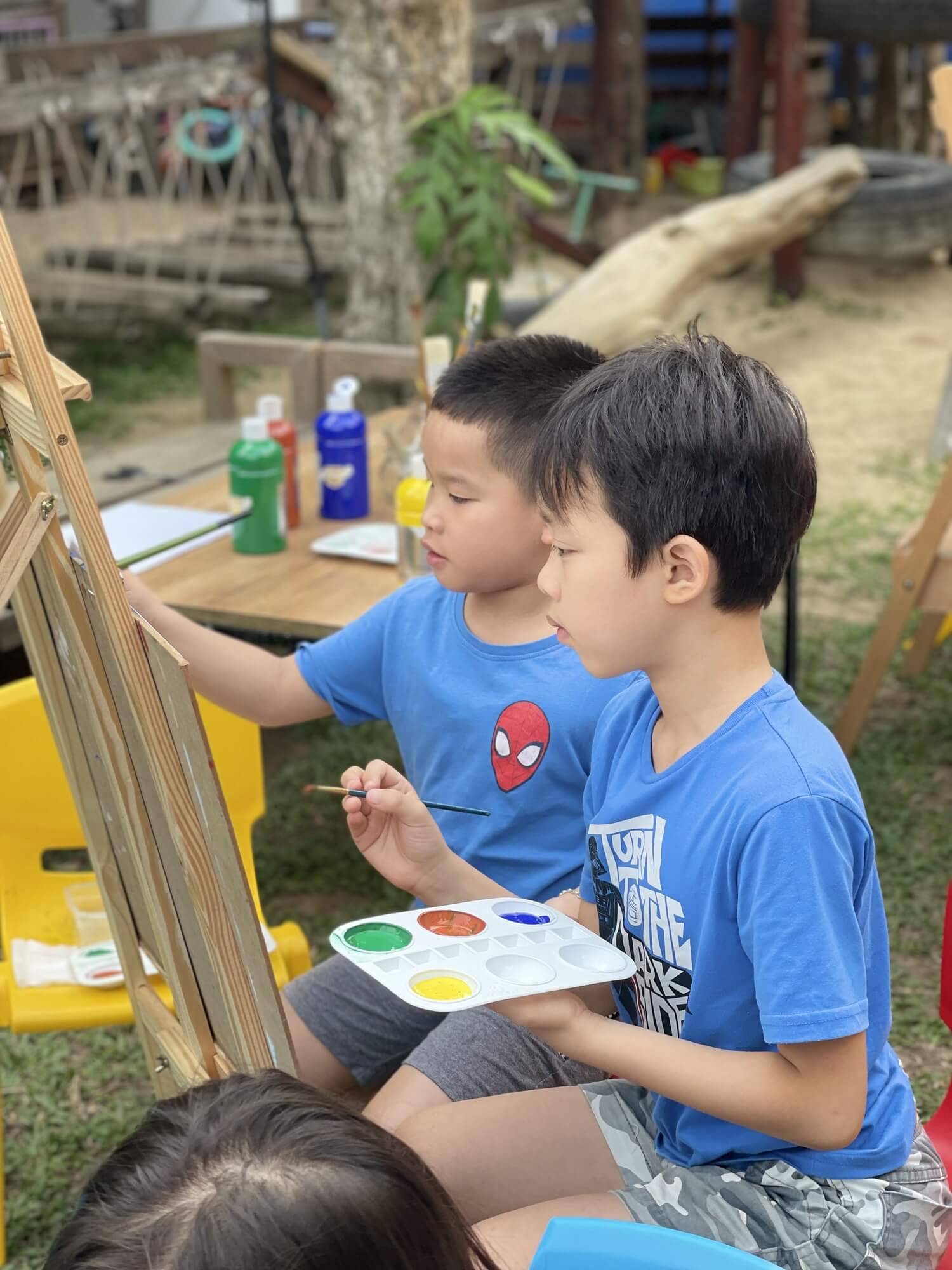
In 4Life Montessori Senior class, art activities include drawing, painting, design work, collage, printing, flower arranging, sewing and handiwork, modelling with clay, colour mixing, art appreciation cards, wall pictures, and stories. Techniques and processes for using different media are shown to the children in discrete activities presented individually or in small groups. All the materials for each activity are kept together, and children are free to choose the activity, and explore the media, and processes involved, independently. There should, however, be a limited amount of art available at any given time. Two, or at the most, three different kinds of media at a time are sufficient.
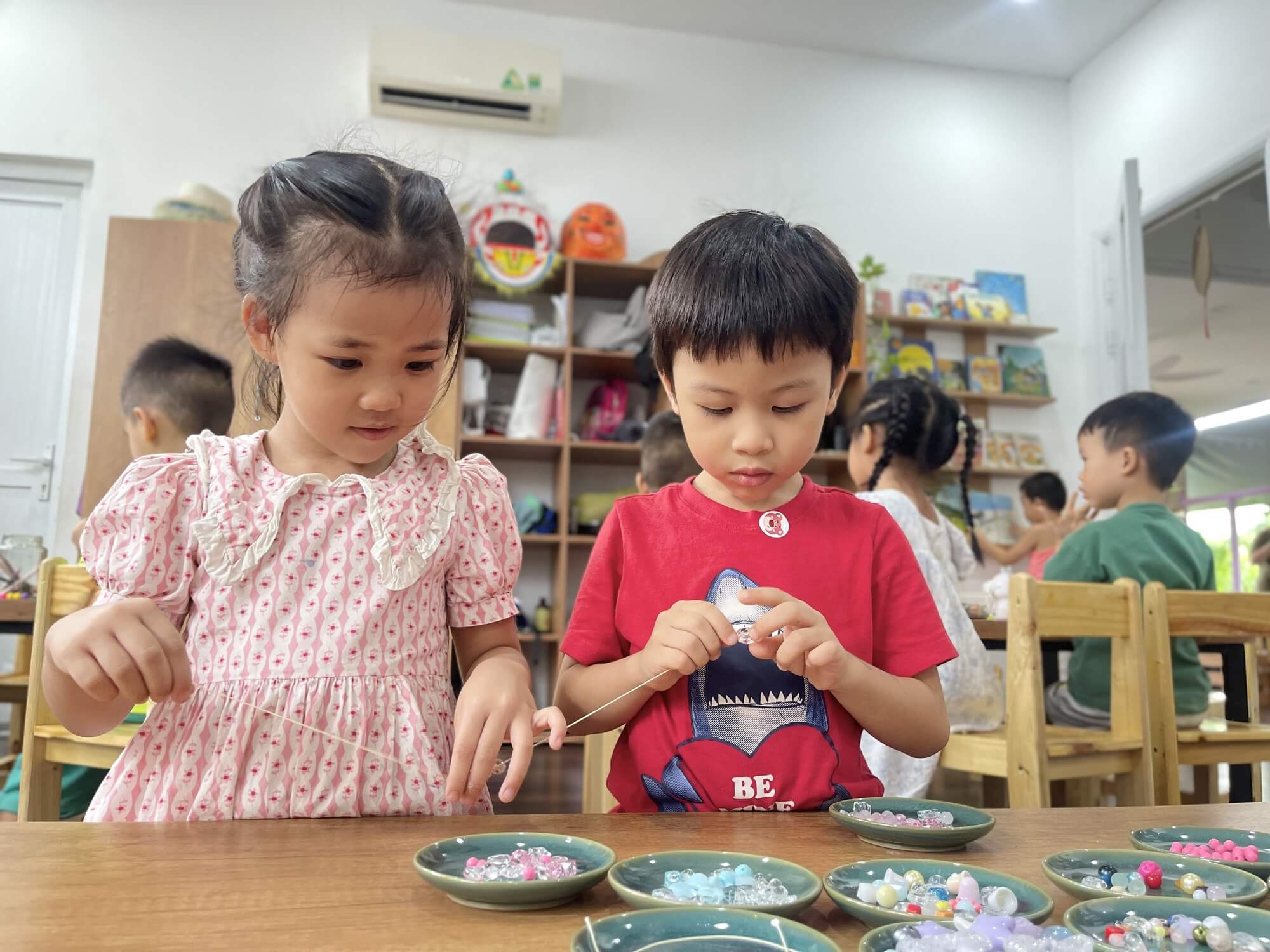
6.3 Movement and Dance
The development and refinement of movement is an integral part of the child’s development from birth to six years of age. The ability to appreciate dance and to be able to move one’s body as a form of expression is an important facet of children’s development. The focus on specific movements can assist children’s development
in many other areas, for example whole body coordination. Dance is also an important aspect of health and physical exercise. Young children have a natural sense of rhythm and often lack inhibition so dance comes naturally and spontaneously to them.
In 4Life Montessori Senior program, there are many walking on the line activities that involve control and coordination of movement. The silence game involves practice in inhibition of movement and stillness of the body. Additional movement on the line activities call for increasing control when marching, running and skipping/galloping along with recognition of the rhythmical notation that calls for these kinds of movements.
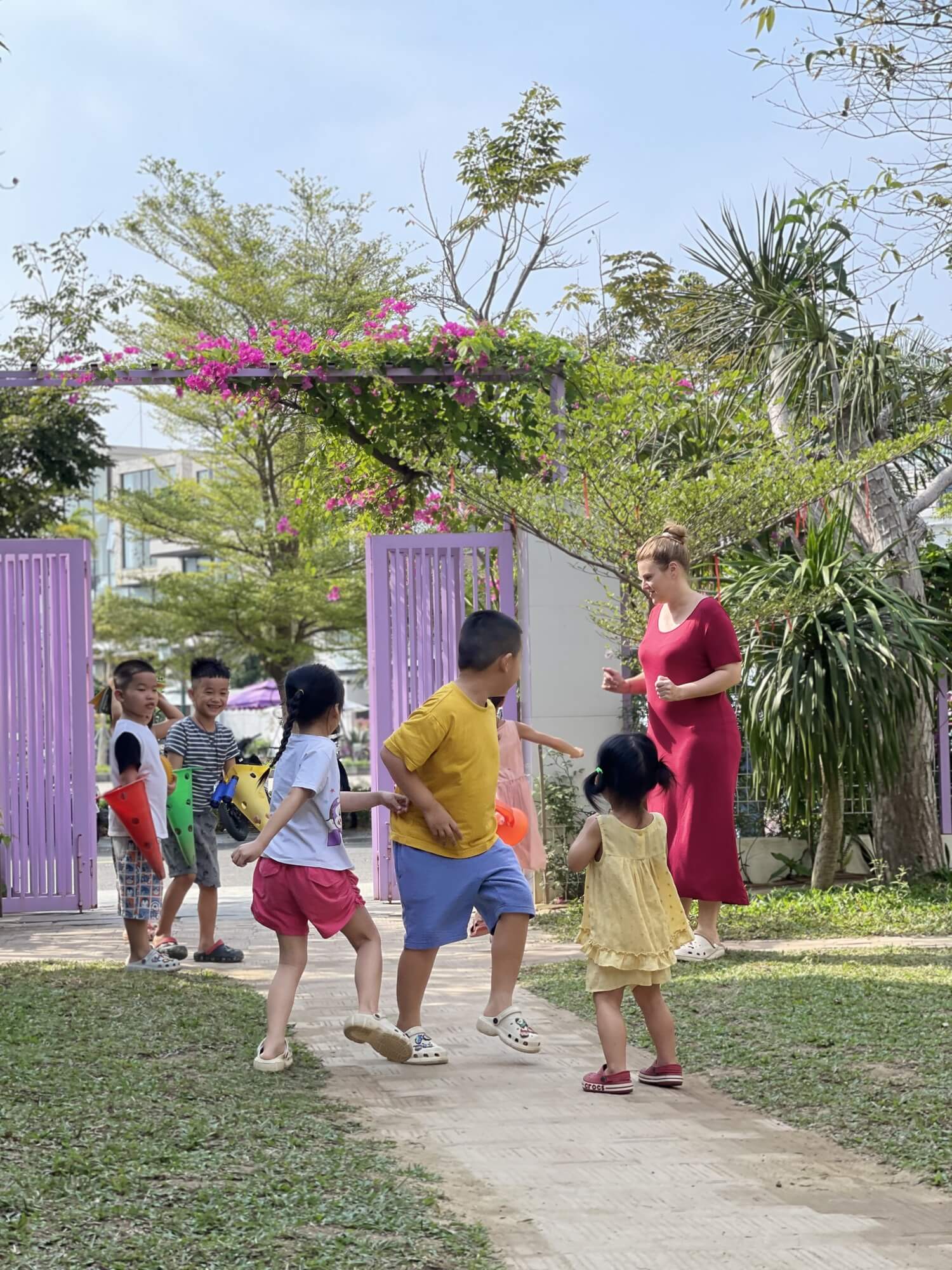
7. Personal Development, Health and Physical Education (PDHPE)
4Life Montessori curriculum provides opportunities for students to gain an understanding of their personal development and health while providing opportunities for physical education and fitness. We incorporated physical activity into our approach to education, devising gymnastic equipment, open-air games and outdoor adventure education. The development of coordinated movement from birth is central to the Montessori approach. Dr Montessori also observed how children’s ability to self-regulate, a phenomenon she termed the will, develops gradually from infancy through the childhood years if children are supported to become physically and socially independent. The will is developed during early childhood, in the Montessori view, when children can choose purposeful activities they find interesting and which involve manipulation, and then are given the freedom to work with those activities for as long they wish. Through such activity, in which the mind and the hand come under voluntary control, children learn how to make appropriate choices, how to accept the consequences of their actions and how to preserve, and how to work towards achievable goals and expectations.

7.1 Personal Development, Incorporating the Lessons of Grace and Courtesy
Personal development in Montessori early childhood settings revolves around the lessons of grace and courtesy, the Montessori lessons designed to ensure the needs of everyone in the setting are respected and to promote social harmony. These lessons are given to individual children, small groups or to the whole group. The lessons can be given:
• at point of need
• to prepare children for social situations they will experience in the future
• in response to children demonstrating they need more knowledge about how to manage a social situation, but at a later time so not to embarrass the children or make them feel self-conscious
Many grace and courtesy lessons are how to lessons that model for children how to, for example:
• put a chair under a table without disturbing others
• interrupt politely
• introduce one person to another.
The lessons include information about:
• how to move and use objects with care and control without causing disturbance or harm
• how to gesture appropriately, for example, indicate, smile or shake hands
• what language to use in each situation, for example, politeness terms such as please, thank you and excuse me.
Because there is only one of each set of materials in the environment, children in Montessori settings learn to take turns and consider others. In addition they learn to respect the time and space others need to complete their work undisturbed.
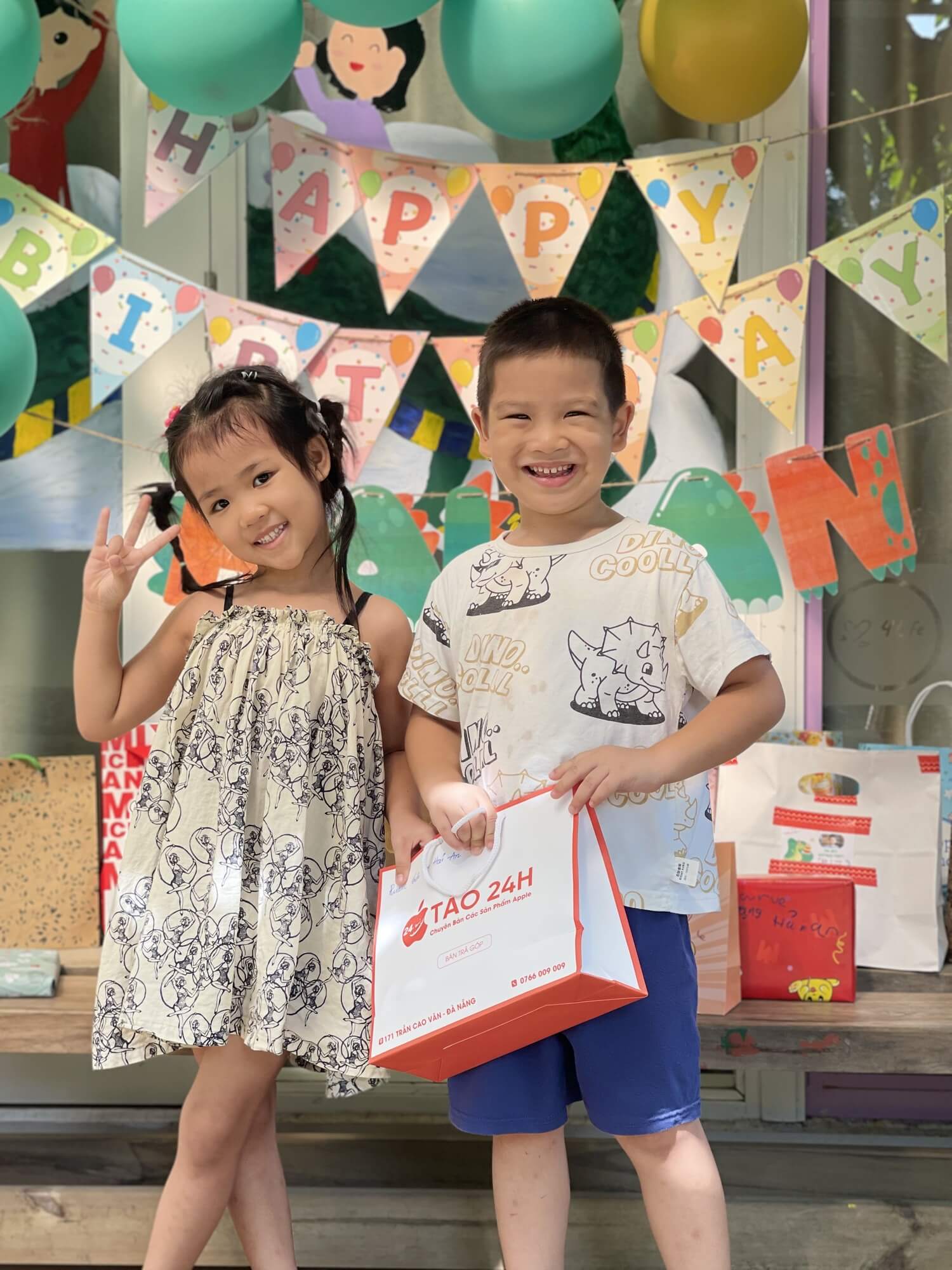
7.2 Health Awareness
4Life Montessori environments recognise the importance of psychological security and wellbeing, encouraging children to become independent, curious, courageous and considered risk takers. We emphasised the importance of fresh air, exercise, hygiene and good nutrition for children.
4Life Montessori settings are kept meticulously clean. In the practical life area of the curriculum, children learn to care for themselves and their surroundings. These lessons begin in the Nursery, Junior and continue into the Senior program. For example, children learn how to:
• wash their hands, blow their nose, use the toilet, care for their clothes, put on a hat, dress themselves
appropriately for the weather, prepare food, eat and clean up after themselves
• keep their surroundings clean, put dirty cloths and clothing into the laundry and ensure equipment, surfaces
and work areas are tidy, clean and ready for the next person.
Children are encouraged to plant and care for healthy foods in the school garden and to harvest, prepare and/or cook them, and then serve them to other children and/or family and friends.
Children are engaged in conversations and lessons relating to topics such as nutrition and safety, including sun and road safety.
Children are encouraged to participate in regular physical activity, both indoors and outdoors.
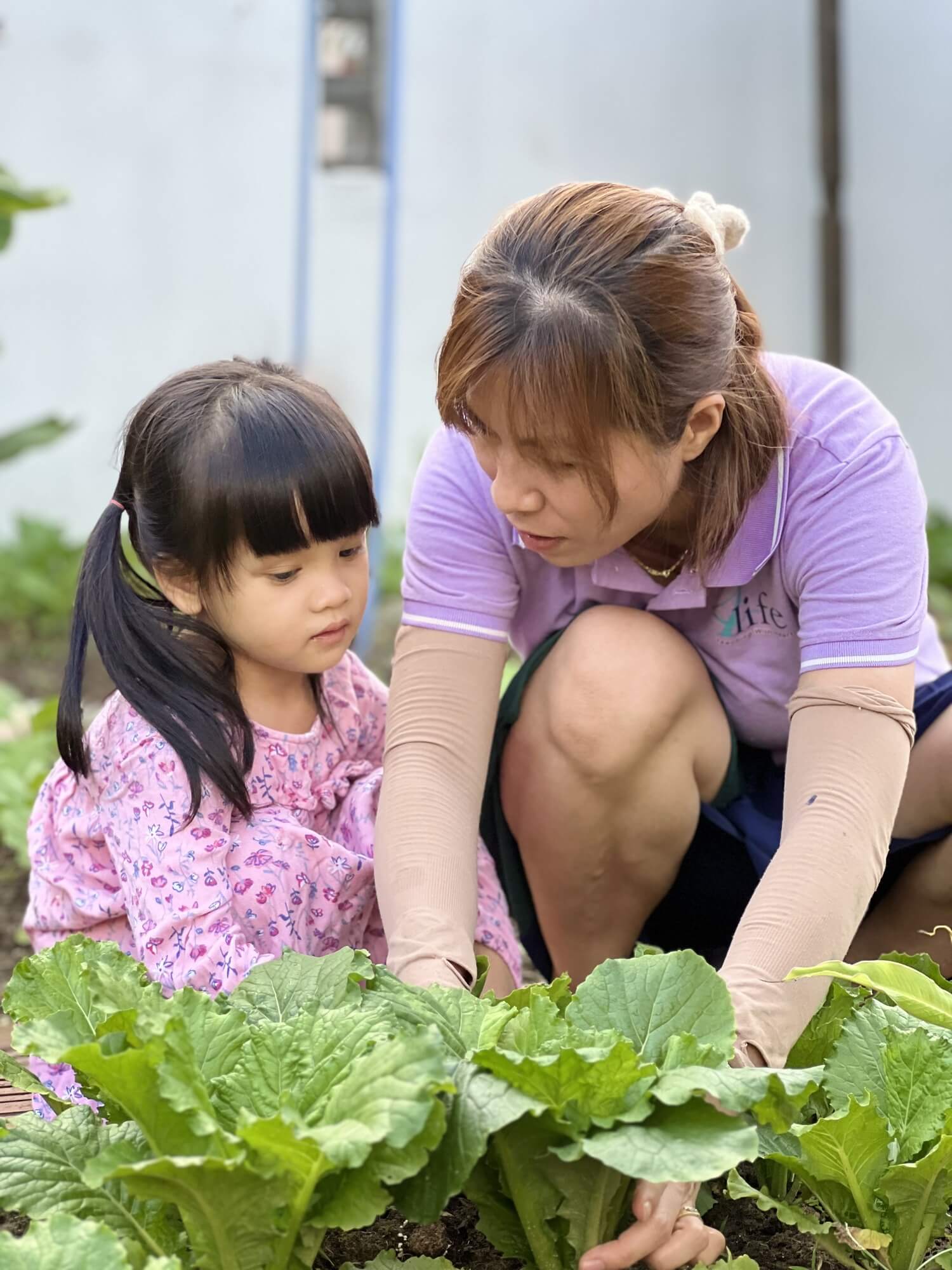
7.3 Physical Education
Regular physical activity is an essential component of Montessori early childhood settings. Young children move constantly and need movement in order to learn. 4Life Montessori settings are prepared to allow children freedom of movement while, at the same time, activities are designed to enable children to develop control of their physical movement. Daily free play outdoors extends opportunities for regular physical activity.
Children also need activities that are challenging and require maximum effort’, and these are provided in the setting, for example, opportunities to move heavy objects in safe ways. These activities are extended in the Senior program to help children develop, strengthen and refine their movement further.
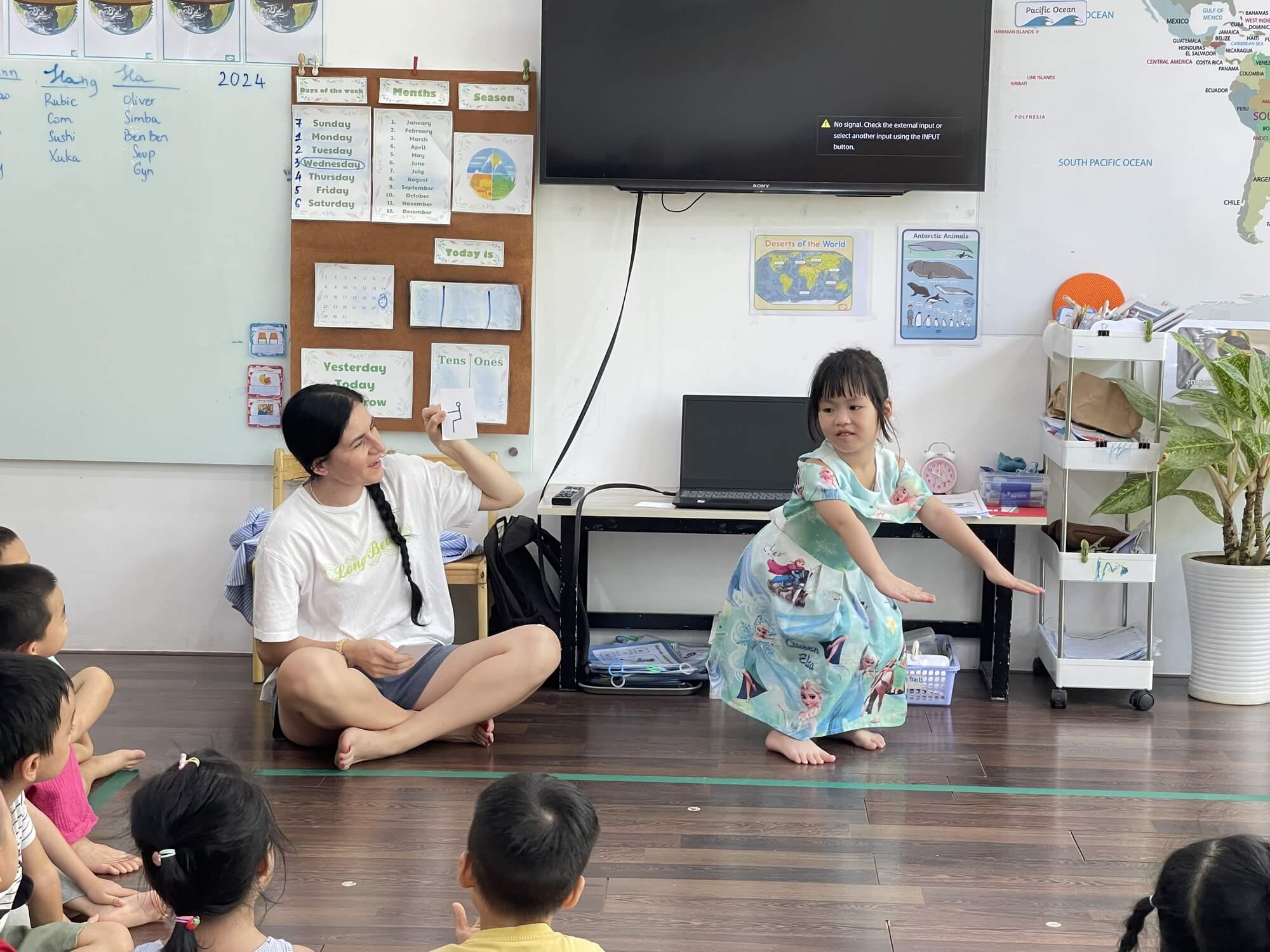
8. Vietnamese language for international children
In the Montessori view, from birth to the age of six, children are in a sensitive period for language development. For this reason, in Montessori early childhood settings, a great deal of emphasis is placed on supporting and enhancing children’s language development. Supporting language development in early childhood settings includes:
• valuing the language/s spoken in each child’s home, and the language development achieved by each child when they enter the early childhood setting
• structured support with the development of spoken English, both for children who speak English as a first
language and for children for whom English is not the language of the home
• systematic preparation for the development of written English (writing and reading)
• engagement with a language other than English.
With the help of teaching assistants and Vietnamese friends, international children can easily learn Vietnamese at all four levels, maximizing their ability to absorb the language present in their environment.
